B 260 RI ComboB 260 RI
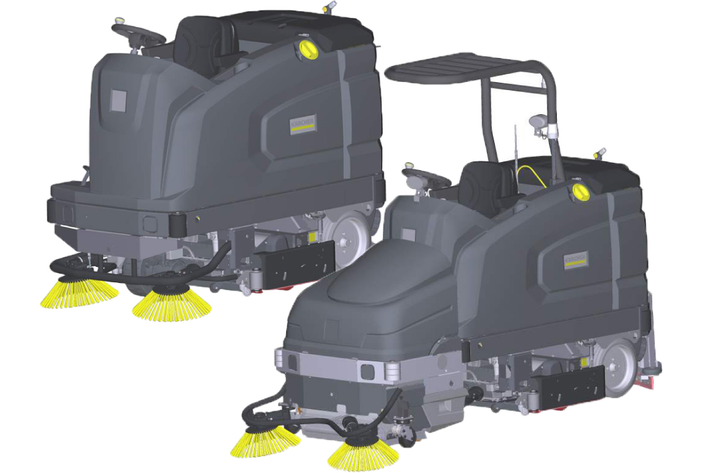
5.980-047.0 (01/25)

5.980-047.0 (01/25)
 Read these original operating instructions and the enclosed safety instructions before using the device for the first time. Proceed accordingly.
Read these original operating instructions and the enclosed safety instructions before using the device for the first time. Proceed accordingly.
Keep both books for future reference or for future owners.
This scouring and vacuum machine is used for wet cleaning or polishing of level floors.
With the Combo variant, loose dirt is picked up by a sweeping mechanism before cleaning.
The device can be adjusted to suit the respective cleaning task by adjusting the water quantity, contact pressure, brush speed, detergent volume and travel speed.
A working width of 1000 mm or 1200 mm and a capacity of 260 l in the fresh and waste water tank each enable effective cleaning with long working times.
The device has a travel drive, the driving motor is powered by a traction battery. The batteries can be charged by means of a charger at a 230-V socket.
Battery and charger are already supplied with the package variants.
The device can be equipped with various accessories to suit the respective cleaning task. Request a copy of our catalogue or visit our Internet website at www.kaercher.com.
This device is suitable for commercial and industrial use, e.g. logistics halls, factories, industrial systems, car parks, trade fairs and retail premises. Use this device only in accordance with the information in these operating instructions.
The device may only be used for cleaning floors that are insensitive to water and polishing.
The device is designed for cleaning indoor floors or covered areas. For other application areas, the use of alternative brushes or the use of the sweeping mechanism must be checked.
The operational temperature range is between +5 °C and +40 °C.
The device is not suitable for cleaning frozen floors (e.g. in cold stores).
With the Combo variant: The device may be driven over steps up to a maximum height of 2 cm.
The device may not be operated without a lint filter in the waste water tank.
The device is not intended for cleaning public traffic routes.
The device must not be used on pressure-sensitive floors. Take into account the permissible load per unit area of the floor. The area load imposed by the device is specified in the Technical data.
The device may only be fitted with original accessories and spare parts.
The device is not suitable for use in potentially explosive environments.
No flammable gases, undiluted acids or solvents may be taken up with the device. These include petrol, paint thinner or heating oil, which can form explosive mixtures in the suction air turbulence. Do not use acetone, undiluted acids or solvents, as these corrode the materials used on the device.
 The packing materials can be recycled. Please dispose of packaging in accordance with the environmental regulations.
The packing materials can be recycled. Please dispose of packaging in accordance with the environmental regulations.
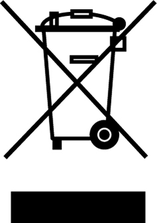 Electrical and electronic devices contain valuable, recyclable materials and often components such as batteries, rechargeable batteries or oil, which - if handled or disposed of incorrectly - can pose a potential danger to human health and the environment. However, these components are required for the correct operation of the device. Devices marked by this symbol are not allowed to be disposed of together with the household rubbish.
Electrical and electronic devices contain valuable, recyclable materials and often components such as batteries, rechargeable batteries or oil, which - if handled or disposed of incorrectly - can pose a potential danger to human health and the environment. However, these components are required for the correct operation of the device. Devices marked by this symbol are not allowed to be disposed of together with the household rubbish.
Current information on content materials can be found at: www.kaercher.de/REACH
The warranty conditions issued by our relevant sales company apply in all countries. We shall remedy possible malfunctions on your appliance within the warranty period free of cost, provided that a material or manufacturing flaw is the cause. In a warranty case, please contact your dealer (with the purchase receipt) or the next authorised customer service site.
Further information can be found at: www.kaercher.com/dealersearch
Further warranty information (if available) can be found in the service area of your local Kärcher website under "Downloads".
Only use original accessories and original spare parts. They ensure that the appliance will run fault-free and safely.
Information on accessories and spare parts can be found at www.kaercher.com.
Check the contents for completeness when unpacking. If any accessories are missing or in the event of any shipping damage, please notify your dealer.
Before using the device for the first time, read and observe these operating instructions and the accompanying brochure: Safety instructions for brush cleaning devices, No. 5.956-251.0.
The device is approved for operation on surfaces with a specified limited slope (see chapter "Technical Data").
The device can tip over
Risk of injury
Only operate the device on surfaces that do not exceed the permitted slope (see chapter "Technical Data").Risk of accident due to incorrect operation
People can be injured.
Operators must be properly trained on how to use this machine.The device may only be operated when the hood and all covers are closed.
The Li-Ion version has built-in lithium-ion batteries. These are subject to special criteria. Removal and installation as well as testing of defective batteries may only be carried out by Kärcher customer service or a qualified specialist.
For storage and transport instructions, please contact your Kärcher Customer Service.
Modifications and alterations to the device are not permitted.
You must not open the battery, there is a danger of a short circuit. Irritating vapours or corrosive liquids can also escape.
Do not expose the battery to strong sunlight, heat or fire. There is a danger of explosion.
Do not operate the charger in an explosion-hazard environment.
Do not use a dirty or wet charger.
Ensure sufficient ventilation during the charging process.
Danger of explosion. Keep naked flames away from the battery or the battery charging room, and do not generate sparks or smoke in the vicinity of a battery of a battery charging room.
Danger of explosion. Do not place any tools or objects on the battery, i.e. on the end poles and cell connectors.
Check the device and the mains cable for damage before each use. Do not use damaged devices and have damaged parts repaired by qualified personnel only.
Keep children away from batteries and charger.
Do not charge damaged batteries. Have damaged batteries replaced by Kärcher customer service.
Do not throw a defective battery in the household rubbish. Inform Kärcher Customer Service.
Avoid contact with fluid leaking from defective batteries. In case of accidental contact, rinse the liquid with water. In case of contact with the eyes, consult a doctor as well.
Be sure to observe these operating instructions. Adhere to the recommendations of the legislature regarding the handling of batteries.
The mains voltage must match the voltage indicated on the type plate of the device.
Use the charger for charging approved battery packs only.
Operate the battery only with this device. It is forbidden and dangerous to use it for other purposes.
Risk of injury due to missing or modified safety devices!
Safety devices are provided for your own protection.
Do not bypass, remove or render ineffective any safety devices.For immediate shutdown of all functions: Set the safety switch to "0".
The device brakes hard when the safety switch is switched off.
The safety switch acts directly on all device functions
If the operator leaves the seat during work or while driving, the seat switch switches off the engine after a short delay.
Observe the following warnings when handling the batteries:
 | Observe notes in the instructions of the battery, on the battery and in these operating instructions. |
 | Wear eye protection. |
 | Keep acids and batteries away from children. |
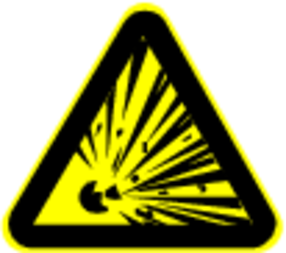 | Risk of explosion |
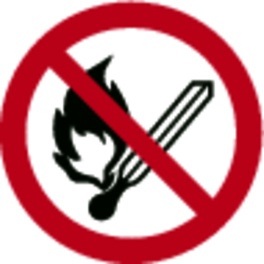 | Fire, sparks, open flames and smoking are prohibited. |
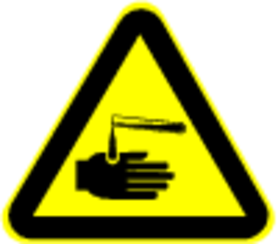 | Risk of acid burns |
 | First aid. |
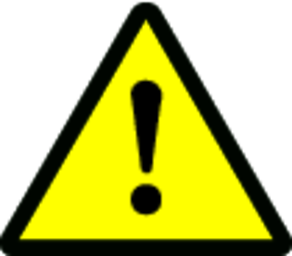 | Warning |
 | Disposal |
 | Do not dispose of used batteries in the residual waste. |
Risk of injury through heat and explosion if the batteries are short-circuited!
If batteries are short-circuited, very high currents flow that can strongly heat objects and cause fires. Heat and sparks can cause explosions.
Do not short-circuit the batteries. Do not place any objects on the batteries.Do not wear electrically conductive objects (e.g. jewellery, watches, necklaces) on your body or in/on your clothing.Only use insulated tools.Risk of injury!
Ensure that wounds never come into contact with lead.Always clean your hands after working on batteries.
Risk of fire
If plugged into an unsuitable socket or in the event of poor electrical connection between the plug and the socket, the charger plug and the socket used may get very hot.
Before plugging in the mains plug, make sure that the socket is approved for a current of 16 A and that it is in a technically sound condition.Make sure that the mains plug is clean and in a good condition.Do not operate the device together with other devices on an extension cable with multiple power sockets.
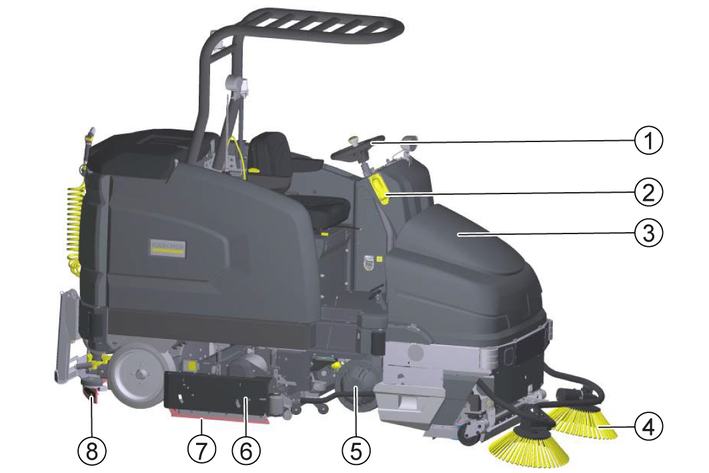
* Optional
*** Combo variant only
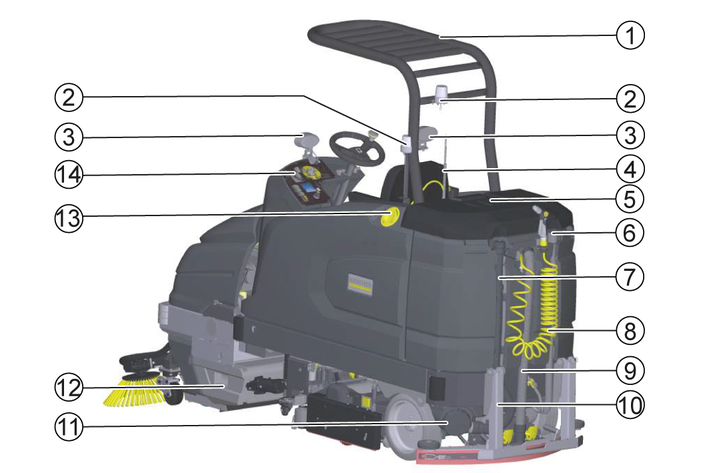
* Optional
*** Combo variant only
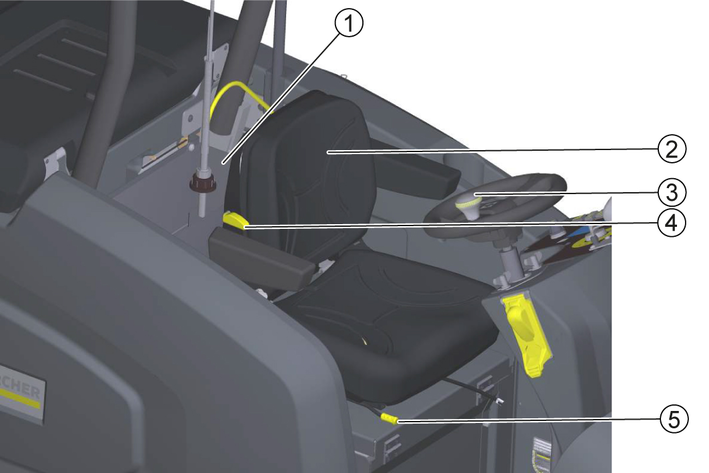
* Optional
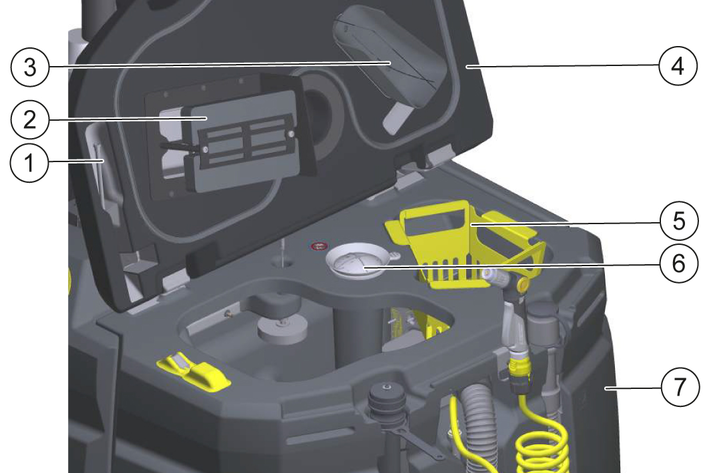
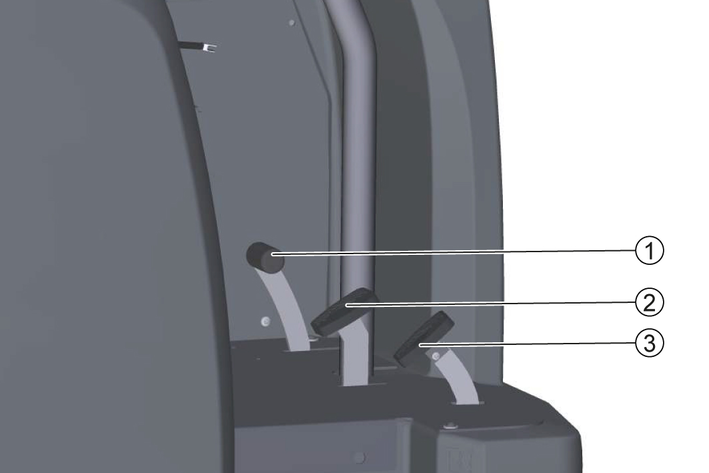
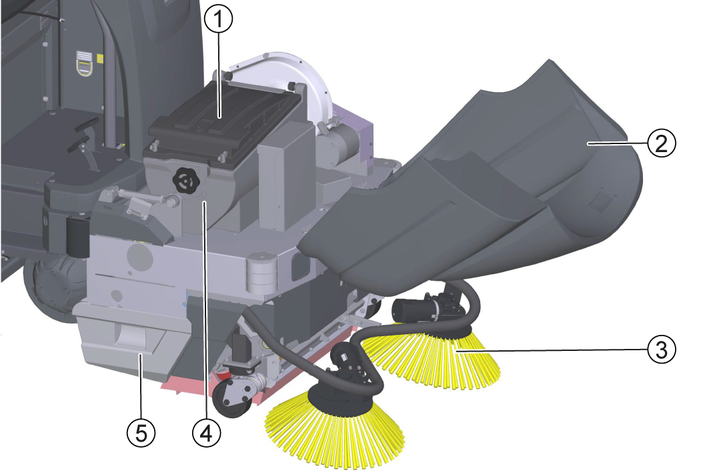
*** Combo variant only
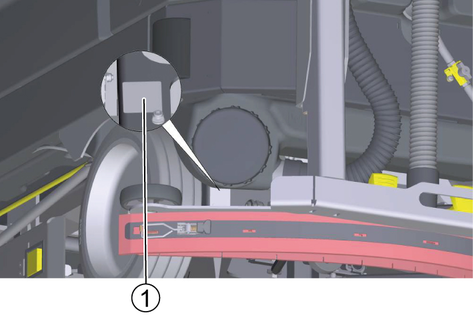
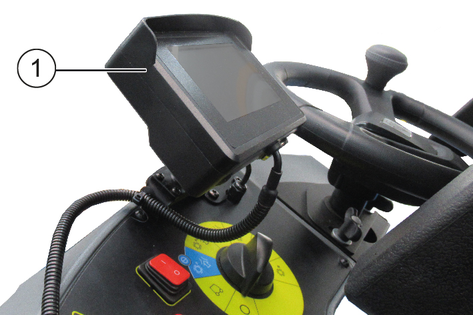
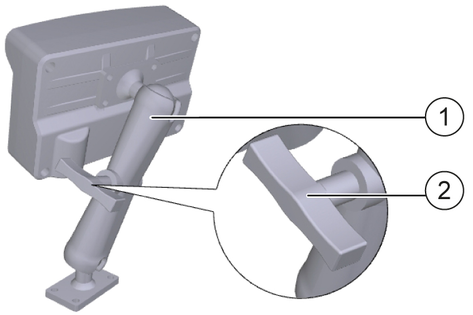
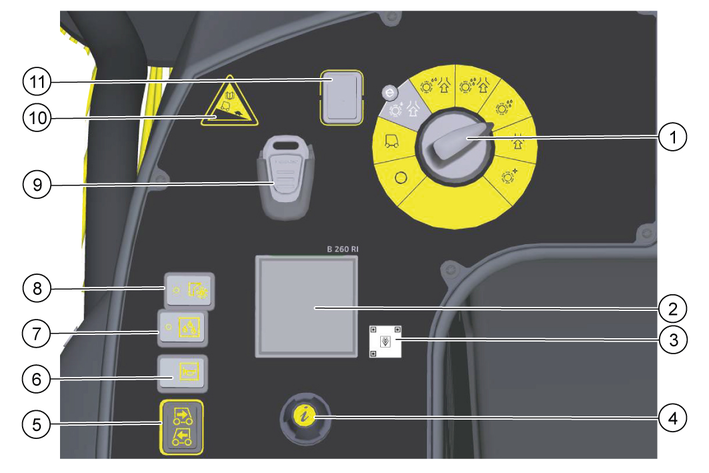
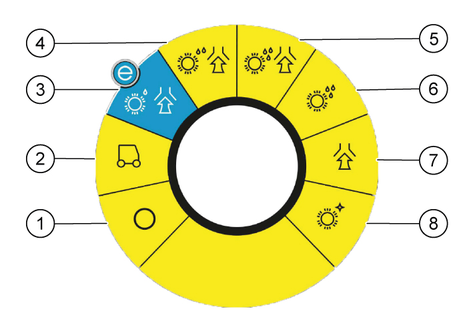
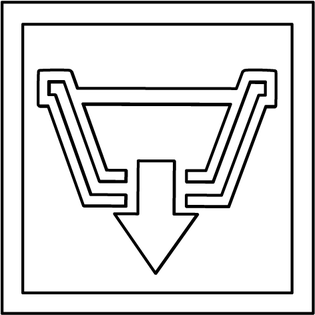 | Drain for fresh water |
 | Drain for waste water |
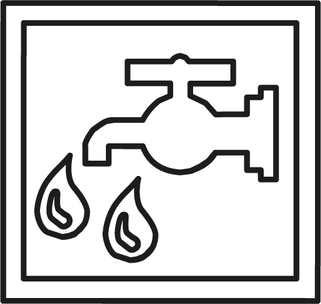 | Fresh water |
 | Fresh water tank automatic filling system |
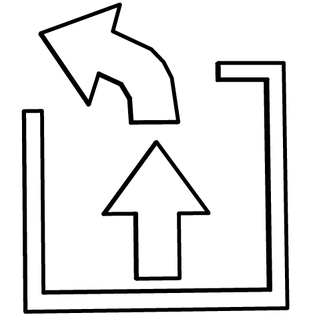 | Removing the coarse dirt basket |
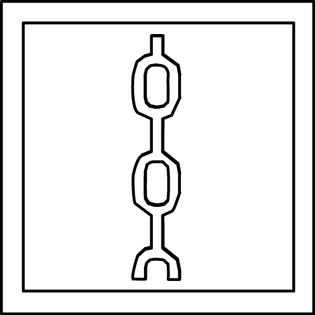 | Lashing point |
* Optional
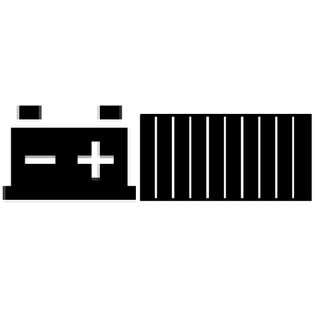 | Battery full |
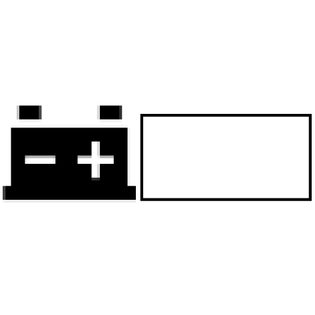 | Battery empty |
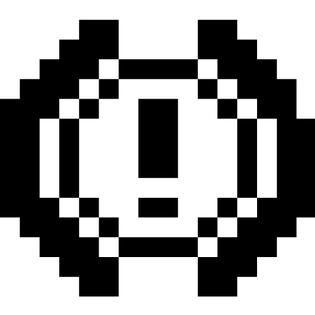 | Brake activated |
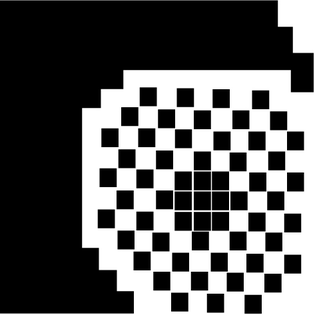 | Preliminary sweep work activated |
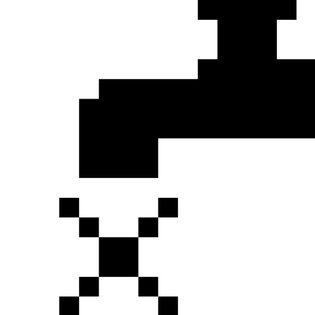 | Water off |
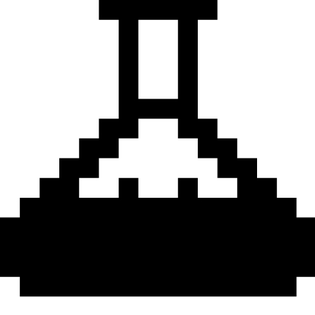 | Detergent activated |
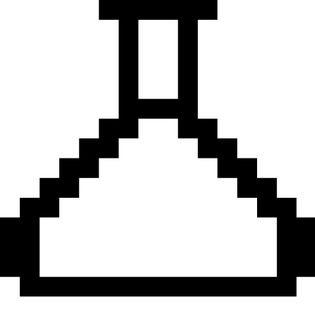 | Detergent empty |
 | Fresh water 100% |
 | Fresh water 0% |
Order no. | |
Battery set (wet) 36V/630Ah | 2.815-108.0 |
Charger | 4.035-191.0 |
Volume (m3)* | 71,78 |
Air flow (m3/h)** | 27,71 |
Order no. | |
Battery set (Li-Ion) 36V/525Ah | 2.654-000.0 |
Charger | 6.654-543.0 |
* Minimum volume of battery charging room
** Minimum air flow between battery charging room and environment
Batteries and chargers are available from specialist shops.
Length | Width | Height |
|---|---|---|
842 | 627 mm | 537 mm |
The following must be observed when fitting the wet batteries:
The maximum battery dimensions must be observed.
The seat must be pivoted up when charging wet batteries.
The battery manufacturer's regulations must be observed when charging wet batteries.
The batteries are already installed in the Bp variant. If you did not receive a Bp variant, the batteries were retrofitted at the national company or at your trusted dealer. This may be for availability, time, cost, import, service, transport or similar reasons to your advantage.
Risk of damage to the control electronics!
The control electronics can be destroyed by reversing the polarity of the battery connections.
Take care to ensure the correct polarity when connecting the batteries.Adjust the steering wheel position all the way forward.
Pivot the seat forward.
Remove the seat stop screw.
Remove the plug of the seat contact switch and push it back through the opening.
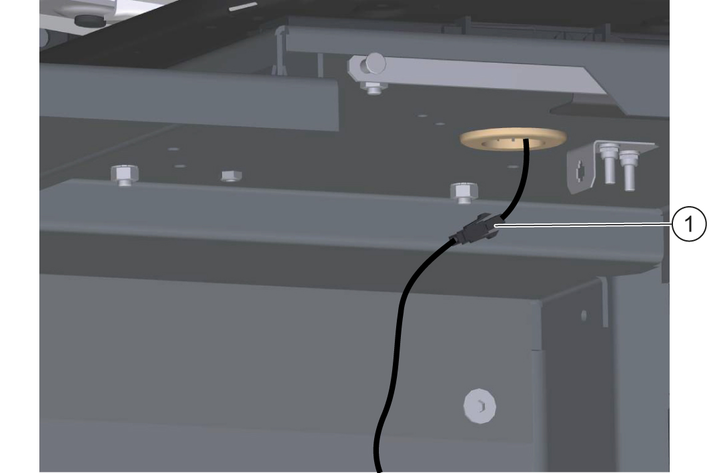
Unlock the seat and pull it upwards.
Remove the seat contact switch plug from the holder.
Unhook the support for the seat console and close the seat console.
Unscrew the hinges of the seat console.
Place the seat console in the footwell.
Only with Dose variant: Remove the detergent canister tray.
Only with Fleet variant: Remove the cables.
Lift off the battery cover.
Remove the fresh water tank on the right.
Remove the battery box side panel on the right.
Fit the battery. Battery terminals positioned at the front in the travel direction.
Only for wet battery:
Clamp the supplied power cables to the (+) and (‑) battery terminals that are still free. Route the cable so that it cannot be pinched by the seat.
The Li-ion battery is supplied with the plug connection connected.
Only with Fleet variant: Install the cables.
Install the battery box side panel on the right.
Install the fresh water tank on the right.
Fit the battery cover.
Insert the battery plug.
Fit the seat console.
Screw on the hinges of the seat console.
Open the seat console and hook in the seat console support.
Install the seat contact switch plug on the holder.
Fit the seat.
Plug in the seat contact switch plug.
Install the seat stop screw.
Pivot the seat downwards.
Adjust the steering wheel.
Danger to life from fire or explosion if batteries are deeply discharged!
Incorrect charging of deeply discharged batteries can cause a fire.
Do not start the device if the battery is deeply discharged.Make sure that the battery is charged before starting the system.The device has deep discharge protection. I.e. with lead acid batteries, the device can only be driven when the permitted minimum capacity level is reached. "Battery empty- please charge" appears in the display. Cleaning operation is not restricted for devices with Li-Ion batteries.
When using other batteries (e.g. from other manufacturers), the deep discharge protection for the respective battery must be reset by Kärcher Customer Service.
Danger of death from electric shock!
Danger of explosion when charging the battery!
There is a danger of electrical shock if the charger is used improperly
Flammable gases are generated when the battery is charged
Adhere to the mains voltage and fuse values specified on the device type plate.Only use the charger in dry rooms with sufficient ventilation.Only charge the batteries in a suitable room. The room must have a minimum volume depending on the battery type and an adequate air exchange rate with a minimum air flow (see "Recommended batteries").Only charge wet batteries with the seat pivoted up.If the device has a Li-ion battery, it is the battery that switches off when the charge level is too low, not the device. From a charge level of <15%, <10% and <5%, the system also emits acoustic signals with increasing intensity.
The average charging time for wet batteries is approx. 10-12 hours.
The average charging time of the Li-Ion batteries is approx. 3 hours.
The recommended chargers (for the respective batteries) are electronically controlled and end the charging process automatically.
The device cannot be used during the charging process.
Drive the device directly to the charger and do not drive on slopes.
Pivot the seat upwards.
Connect the charging cable to the battery.
With lead battery variant: Disconnect the battery plug and connect it to the charging cable.
With Li-Ion battery variant: Connect the charger cable to the battery via the separate plug connection.
Connect the charger to the mains and switch it on.
Lead battery:
Switch off the charger and disconnect it from the mains.
Disconnect the battery cable from the charging cable and connect it to the device.
Route the charging cable in the battery compartment so that it cannot be pinched.
Li-Ion battery:
Disconnect the plug connector for the charger.
The connector from the Li-ion battery to the device remains connected during charging.
Refilling discharged batteries with water
Danger of acid burns from escaping acid, destruction of clothing
Wear safety goggles, protective clothing and protective gloves when handling the battery acid.Observe the applicable regulations.Immediately rinse off any splashed acid from the skin or clothing using copious amounts of water.Using water with additives
Defective batteries, loss of warranty eligibility
Top up the batteries using only distilled or desalinated water (EN 50272-T3).Do not use any foreign additives, so-called enhancing agents, because this will invalidate the warranty.Add distilled water one hour before the charging process comes to an end. Observe the correct acid level according to the battery label.
All cells must produce gas at the end of the charging process.
Clean up any spilled water. To do this, proceed as described in the Care and maintenance chapter in the "Cleaning the batteries" section.
Wet battery variant:
The charging state of the batteries is shown on the control panel display.
The length of the bar shows the battery charging state.
Li-Ion battery variant:
The battery charging level is displayed on a separate screen of the battery system.
The percentage SoC (State of Charge) indicates the charge state.
Set the safety switch to the "0" position to shut down all functions immediately.
Remove the packaging film.
Remove the strap.
Unscrew the unloading planks and squared timber from the pallet.

Place the squared timber in front of the pallet.
Place the unloading plank on the squared timber.
Screw on the unloading plank.
Push the block provided in the packaging under the ramp to provide support.
Remove the wooden strips in front of the wheels.
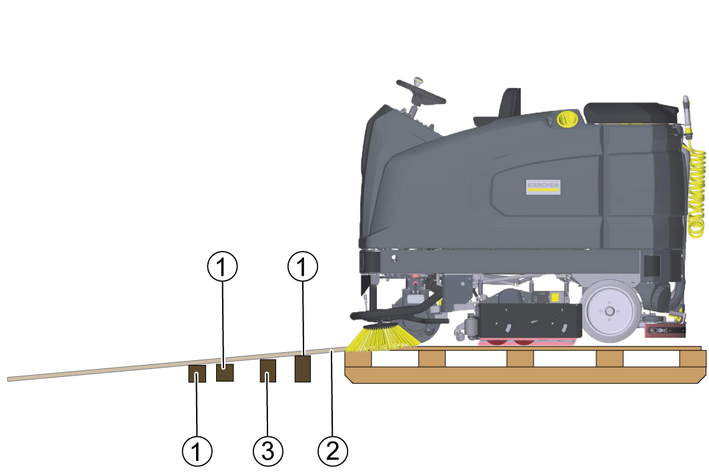
Push the device forwards off the pallet.
Install the suction bar only after unloading.
Release the parking brake via the lever (see chapterPushing the device ).
One person must sit on the seat and press the brake pedal in the case of danger during pushing.
Push the device down the ramp and off the pallet.
Close the parking brake with the lever.
The batteries must be installed and charged in order to drive off the pallet.
Install the suction bar only after unloading.
Insert the Intelligent Key into the control panel.
Switch on the device using the Easy-Operation switch.
Set the program switch to transport travel.
Set the travel direction switch to "Forward".
Depress the accelerator pedal.
Drive the device slowly off the pallet.
Switch off the device using the Easy-Operation switch.
The disc brushes must be installed before start-up (see chapter Maintenance work).
The brushes are installed.
Pivot both clamping levers upwards.
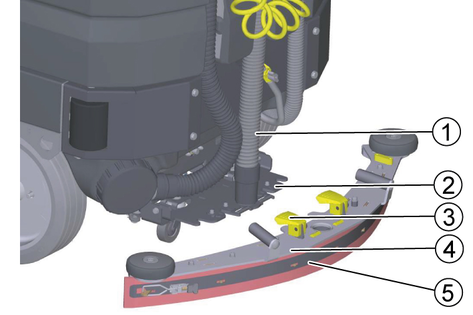
Fit the suction bar in the suction bar mount.
Pivot both clamping levers downwards.
Falling objects
Risk of injury
Do not used the device without an overhead guard to protect against falling objects in areas in which there is a possibility of operators being hit by falling objects.Risks during operation
Risk of injury
In the event of danger, set the safety switch to "0".Sit in the driver's seat.
Insert the Intelligent Key.
Only for Li-Ion battery: Press the on/off button on the bottom edge of the separate display.
Set the safety switch to position "1".
Turn the program selection switch to the desired function.
If one of the displays below appears on the display, take your foot off the accelerator pedal, set the safety switch to "0" and carry out the necessary maintenance work.
Display | Activity |
|---|---|
Suction bar maintenance | Clean the suction bar. |
Brush head maintenance | Check the brushes for wear and clean them. |
Suction lip maintenance | Check the suction lips for wear and adjustment. |
Turbine sieve maintenance | Clean the turbine screen. |
Maintenance of the fresh water filter | Clean the fresh water filter. |
Press the Info button.
Reset the counter for the corresponding maintenance (see "Grey Intelligent Key / Reset maintenance counter").
If the counter is not reset, the maintenance display appears again each time the device is switched on.
Danger of death due to defective parking brake!
The device may roll uncontrollably if the parking brake is not working properly.
Check the function of the parking brake on level ground before each use.Switch the device on.
Set the travel direction switch to "Forward".
Set the program switch to transport travel.
Press the accelerator pedal lightly.
The brake must audibly unlock. The device must roll easily on level ground.
Release the accelerator pedal.
The brake must audibly lock.
If the parking brake does not lock, shut down the device, secure it against uncontrolled rolling and contact the customer service.
Danger of accident due to defective foot brake!
The device may roll uncontrollably if the foot brake is not working properly.
Check the function of the parking brake on level ground before each use.Switch the device on.
Set the travel direction switch to "Forward".
Set the program switch to transport travel.
Press the accelerator pedal.
While driving, take your foot off the accelerator and apply the foot brake.
Device must decelerate noticeably.
If this is not the case, shut down the device and call Customer Service.
Lack of braking
Danger of accident
Before using the device, it is essential to check the function of the parking brake. Never use the device if the parking brake does not work.No braking effect during operation
If the device no longer has any braking effect during operation, proceed as follows:
If the device does not come to a standstill on a ramp with a gradient of more than 2% when you release the accelerator pedal, for safety reasons you may only set the safety switch to position "0" if you have checked the correct mechanical function of the parking brake before starting up the device.After reaching a standstill, put the device out of operation and call Customer Service.Observe the maintenance instructions for brakes.Careless driving
Pivoting sweeping mechanism on the Combo variant
Danger of tipping over
Increased risk of accidents
Only drive on slopes in the travel direction up to a maximum of 15% (RI variant) and 10% (RI Combo variant). Slopes transverse to the travel direction up to a maximum of 15%.Do not turn up or down gradients.Drive slowly in corners and on wet ground.Only drive the device on stable ground.Be especially careful when reversing.Take the pivoting of the sweeping mechanism into account when steering.The travel direction can be changed while driving. This allows very dull spots to be polished by moving back and forth several times.
Assume a seated position.
Insert the Intelligent Key.
Set the program selection switch to "Transport travel".
Set the travel direction using the travel direction button on the control panel.
Specify the travel speed by pressing the accelerator pedal.
Release the accelerator pedal.
The device stops.
The driving motor is switched off in the event of an overload. A fault message appears on the display. If the controller overheats, the affected power unit is switched off.
Allow the device to cool down for at least 15 minutes.
Set the program switch to "0", wait briefly and set to the desired program.
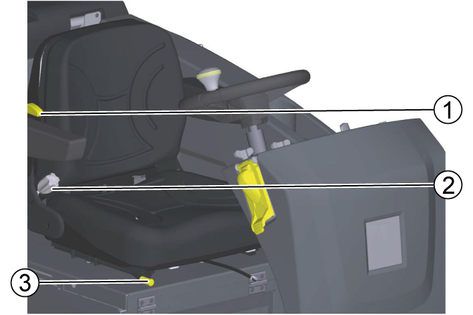
Operate the seat adjustment lever.
Move the seat to the desired position.
Release the seat adjustment lever.
Release the wing nuts for adjusting the steering wheel.
Position the steering wheel.
Tighten the wing nuts.
Damage to the suction turbine!
Operating without a lint filter can damage the suction turbine.
Do not operate the device without the lint filter.Check the following lint filter aspects before starting up the device:
Is it present?
Is it in a usable condition?
Is it installed correctly?
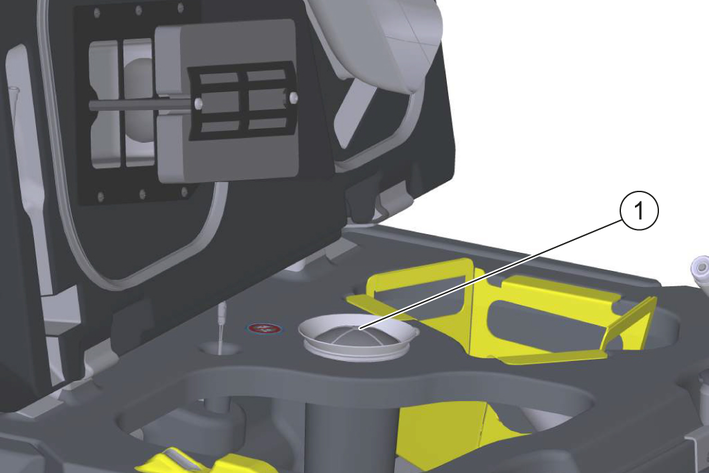
Replace a damaged lint filter.
Release the parking brake by pulling the lever away.
The lever must be pulled all the way.
Risk of injury from rolling device!
The parking brake can only be released while bent over and staying in the danger zone.
Use an object to hold the lever in a permanently pulled state and move away from the danger zone immediately after opening the parking brake.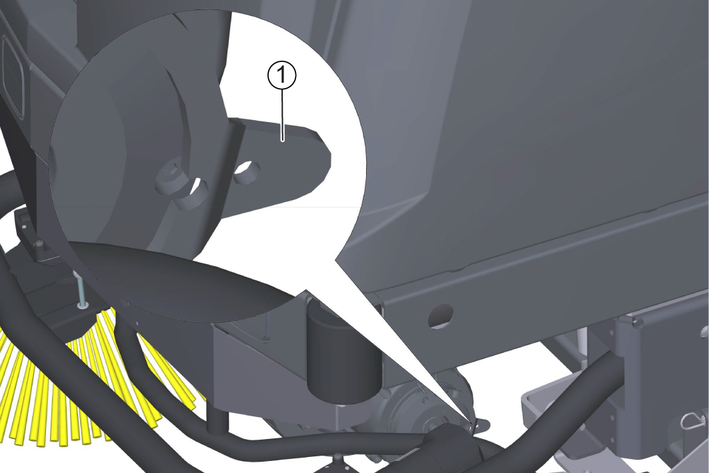
Push the device.
Close the parking brake again by releasing the lever.
Open the fresh water tank cap.
Secure the fresh water hose with the clamp.
Fill fresh water (max. 60 °C) to approx. 5 cm below the filler funnel.
Fill the fresh water tank completely before initial startup in order to vent the water pipe system.
´Remove the fresh water tank cap.
We recommend that you use a hose with an Aquastop coupling on the device side. This minimises the splashing out of water when disconnecting after the filling process.
Connect the water hose to the automatic filling system.
Open the water supply (max. 60 °C, max. 10 bar).
Monitor the filling process, the automatic filling system interrupts the water supply when the fresh water tank is full.
Close the water inlet.
Remove the water hose.
Risk of damage to the device!
If unsuitable detergents are used, the device may get damaged.
Use only recommended detergents. The operator carries all increased risks relating to operational safety and increased risk of accidents if using other detergents.Use only detergents free of solvents, salt and hydrofluoric acid.Adhere to the safety instructions stated on the detergent packaging.Do not use heavily foaming detergent.
Recommended detergents
Application | Detergent |
|---|---|
Maintenance cleaning of all water-resistant floors | APPROX 50 C RM 756 |
Maintenance cleaning with care components | RM 746 RM 780 |
Maintenance cleaning and basic cleaning of industrial floors | RM 69 |
Maintenance cleaning of glossy coverings | RM 755 |
Maintenance cleaning and basic cleaning of fine stone tiles | RM 753 |
Maintenance cleaning and basic cleaning of acid-resistant coverings | RM 751 |
Cleaning and disinfection | RM 732 |
Basic cleaning of all alkali-resistant floor coverings | RM 752 |
Basic cleaning and de-coating of alkali-sensitive floors | RM 754 |
First fill water into the detergent tank, then add the appropriate dosage of detergent to the tank. If the detergent is poured in first, this can lead to strong foaming.
Danger of clogging
When adding detergent to the fresh water tank, the detergent can dry out and disrupt the function of the dosing device.
Rinse the device with clear water after adding the detergent to the fresh water tank: Select a cleaning program with water application, set the water quantity to the highest value, set the detergent dosage to "0".Detergent is added to the fresh water on the way to the cleaning head by a dosing device.
A maximum of 3% detergent can be added with the dosing device. If the dosage is higher, the detergent must be added to the fresh water tank.
Danger of clogging
When adding detergent to the fresh water tank, the detergent can dry out and disrupt the function of the dosing device.
Rinse the device with clear water after adding the detergent to the fresh water tank: Select a cleaning program with water application, set the water quantity to the highest value, set the detergent dosage to 0.Place the canister with the detergent in the detergent tray behind the seat.
Unscrew the canister cap.
Insert the detergent suction lance of the dosing device into the canister.
The device has a fresh water level indicator on the display. Detergent dosing is also stopped when the fresh water tank is empty. The cleaning head continues to work without supply of liquid.
Detergent addition is also stopped when the detergent canister is empty. A message symbol appears on the display. Only fresh water is fed to the cleaning head.
The parameters for the various cleaning programs are preset in the device.
Individual parameters can be changed depending on the authorization of the yellow Intelligent Key.
The modified parameters only remain in effect until a different cleaning program is selected with the program switch.
A grey Intelligent Key must be used for making adjustments if parameters are to be changed permanently. This setting procedure is described in the section "Grey Intelligent Key".
R cleaning head only: Almost all displayed texts regarding parameter settings are self-explanatory. If you need more detailed information about the parameters, please contact the Customer Service.
Fine Clean: Low brush speed for removing grey film from fine stone.
Whisper Clean: Medium brush speed for maintenance cleaning with reduced noise level.
Power Clean: High brush speed for polishing, crystallizing and sweeping.
Set the program switch to the desired cleaning program.
Press the Info button.
Turn the Info button until the desired parameter is displayed.
Press the Info button.
The adjusted value flashes.
Set the desired value by turning the Info button.
Confirm the changed setting by pressing the Info button or wait until the set value is automatically accepted after 10 seconds.
The suction bar only needs to be readjusted in special cases. The factory setting is suitable for most applications.
The inclination must be adjusted so that the suction lips of the suction bar make even contact with the floor over the entire length of the suction bar.
Park the device on a surface without a slope.
Select the "Suction" program.
Drive the device a small distance forwards.
The suction bar is lowered.
Read the spirit level.
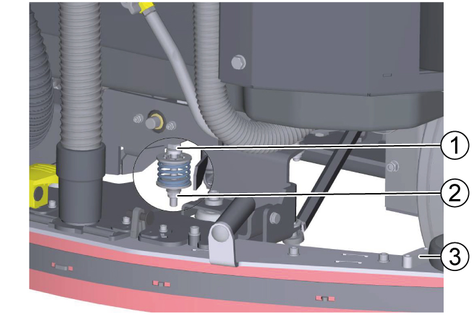
Release the M 12 nut while holding the M 10 hexagon head screw with an open-end wrench.
Adjust the screw so that the spirit level indicator is between the two lines.
Tighten the M 12 nut while holding the M 10 hexagon head screw with an open-end wrench.
To check the new setting, move the device forward a short distance in suction mode with the suction bar lowered and observe the spirit level. Repeat the adjustment process if necessary.
The sweeping mechanism picks up loose dirt before performing floor cleaning.
Moving parts
Danger of injury
Note that the suction turbine, side brushes and filter dedusting run on after switching off.Improper use of the device when sweeping
Risk of damage to the sweeping mechanism.
Do not sweep up packing tape, wires or similar. Only drive over steps up to a maximum of 2 cm.Sweep only dry surfaces to prevent clogging and contamination of the dust filter.Switch on the "Sweeping" switch.
The sweeping mechanism is activated.
The coarse dirt flap can be lifted to sweep up larger objects (up to approx. 6 cm high).
Risk of injury from waste!
Waste can be thrown out when the coarse dirt flap is opened.
Only lift the coarse dirt flap when there are no persons in the vicinity.The sweeping effect and dust suction deteriorate when the coarse dirt flap is raised. Only lift the coarse dirt flap when necessary.
Operate the pedal to raise the coarse dirt flap.
Set the "Sweeping" switch to "0".
The sweeping mechanism is deactivated. After the sweeping operation is finished, the dust filter is cleaned for approx. 15 seconds.
The side scrubbing deck makes working close to the edge easier.
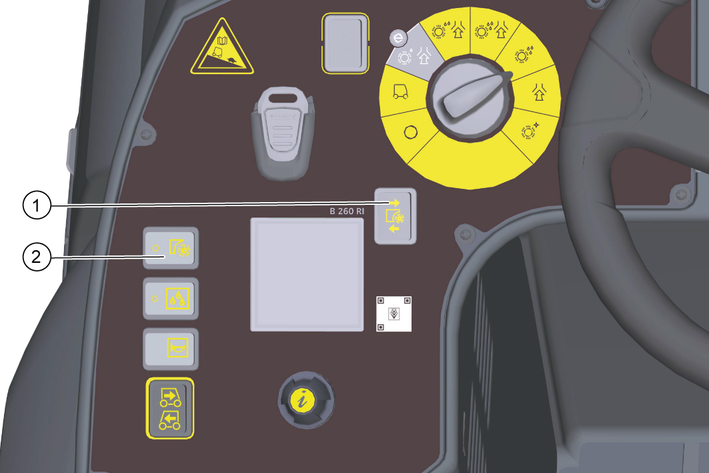
Press the "Switch side scrubbing deck on/off" switch.
The side scrubbing deck is switched on/off.
Press the "Retract/extend side scrubbing deck" switch.
The side scrubbing deck is retracted/extended.
Set the program selection switch to Drive.
Continue moving a short distance.
The residual water is vacuumed up.
Turn the program selection switch to position "0".
Only for Li-Ion battery: Press the on/off button on the lower edge of the separate display until the battery system is put into standby mode.
Set the safety button to "0".
Remove the Intelligent Key.
Risk of injury or damage due to the device rolling away!
If the device rolls away in an uncontrolled manner, parts of the body can be rolled over, trapped or crushed. Material damage can be caused if the device runs into other objects.
Ensure that no operating programme is set and that the accelerator pedal is not depressed.Secure the device against rolling away.Secure the device against rolling away.
Charge the batteries if necessary.
Improper disposal of waste water
Environmental pollution
Observe the local waste water treatment regulations.The suction turbine switches off and the display shows "Waste water tank full" when the waste water tank is full.
Remove the waste water drain hose from the holder.
Lower the end of the hose over the disposal facility.
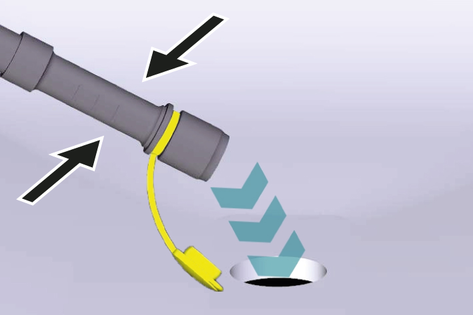
Drain the waste water by opening the cap on the drain hose.
The water flow can be reduced by squeezing or twisting the dosing device.
Remove the spray gun from the holder.
Set the program selection switch to Transport.
Select "Tank rinsing" on the display.
Press the Info button.
Select the "Tank rinsing" menu.
Open the stop valve on the back of the waste water tank.
Rinse the waste water tank with the spray nozzle.
Hang the spray nozzle in the holder.
Close the drain hose cover.
Press the waste water hose into the support on the device.
Close the stop valve at the back of the waste water tank.
Select "Tank rinsing" on the display.
The waste container can only be removed via the driver's side and is only present on R cleaning heads.
Pull the tab.
Pivot open the squeegee blade holder.
Remove the waste container.
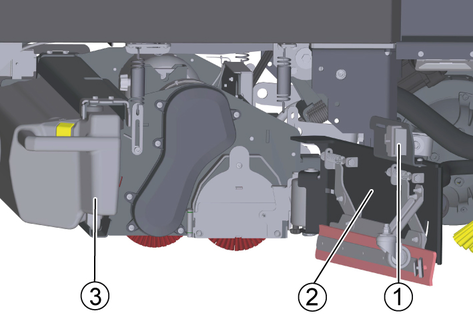
Empty the waste containers.
Fit the waste container.
The waste container must latch into place.
Pivot the squeegee blade holder closed.
Cleaning solution in the fresh water tank
Damage to fresh water tank, valves and seals
Never leave the cleaning solution in the fresh water tank at the end of operation.Remove the fresh water drain hose from the holder and lower it over a suitable collecting device.
Drain the cleaning solution.
Remove the fresh water tank cap.
Rinse the fresh water tank with clear water (maximum 60 °C).
Turn the key-operated switch to "OFF".
Remove the Intelligent Key.
Secure the device against rolling away.
Charge the battery if necessary.
The grey Intelligent Key grants the supervisory staff extended authorizations and setting options.
Insert the Intelligent Key.
Select the desired function by turning the info button.
Set the program selector switch to "Transport travel".
Press the Info button.
The following settings can be made in the Transport travel menu:
Resetting the maintenance counter
Resetting the day counter
Key management
Choosing the brush shape
After-running time
Standard setting
Setting the language
Switch menu
Travel speed
Factory setting
Activating the manual tank rinsing gun
If maintenance work shown in the display has been carried out, the corresponding maintenance counter must then be reset.
Turn the Info button until "Maintenance counter" is displayed.
Press the Info button.
The counter readings are displayed.
Turn the info button until the counter to be cleared is highlighted.
Press the Info button.
Select "Yes" by turning the Info button.
Press the Info button.
The counter is cleared.
The service counter can only be reset by Customer Service staff.
The service counter shows the time until the next service due by Customer Service.
Turn the Info button until "Counter" is displayed.
This menu shows the total operating hours and the day counter.
Delete the day counter:
Press the Info button.
The "Delete counter" menu is displayed.
Turn the Info button until "Day counter" is highlighted.
Press the Info button.
The authorizations are assigned for each yellow Intelligent Key used and the language of the display is set for this Intelligent Key in the "Key menu" menu item.
Insert the grey Intelligent Key.
Turn the info button until the "Key menu" menu item appears on the display.
Press the Info button.
Remove the grey Intelligent Key and insert the yellow or white Intelligent Key to be personalized.
Select the menu item to be changed by turning the info button.
Press the Info button.
Select the setting of the menu item by turning the info button.
Confirm the setting by pressing the menu item.
Select the next menu item to be changed by turning the info button.
After all settings have been made, call up the "Save?" menu by turning the info button.
Press the Info button.
The authorizations are saved.
The "Continue key menu" display appears.
Yes: Program another Intelligent Key
No: Exit the key menu
Press the Info button.
This function is required when changing the cleaning head.
Turn the info button until the "Brush head" menu item appears on the display.
Press the Info button.
Turn the info button until the desired brush shape is highlighted.
Press the Info button.
To change the cleaning head, move the lifting drive by turning the info button:
"Up": Lifting
"Down": Lowering
"OFF": Stopping
Turn the info button until the "OFF" menu item is displayed.
Press the Info button.
The menu is exited.
The controller performs a restart.
Turn the info button until the "After-running time" menu item appears on the display.
Press the Info button.
Turn the info button until the desired function is highlighted.
Press the Info button.
Turn the info button until the desired after-running time is displayed.
Press the Info button.
Turn the info button until the "Standard setting" menu item appears on the display.
Press the Info button.
Turn the info button until the desired accessory is highlighted.
Press the info button to confirm ON/OFF.
Press the info button to exit the menu.
Switch the device off and on again to adopt the setting.
Turn the info button until the "Language" menu item appears on the display.
Press the Info button.
Turn the info button until the desired language is highlighted.
Press the Info button.
The following functions are switched on and off via the "Switch menu":
Detergent dosing*
Flashing beacon/ spotlight*
Side brush spray nozzles*
Spray suction
Work lights
Tank rinsing
The "Switch menu" is available in all program switch positions, except "OFF".
Press the Info button.
The "Switch menu" is displayed.
Press the Info button.
The list of functions available in the device is displayed.
Turn the info button until the desired function is highlighted.
Press the info button to change the switch state.
Turn the Info button until "Exit menu?" is displayed.
Press the Info button.
* Optional
Turn the info button until the "Travel speed" menu item appears on the display.
Press the Info button.
Turn the info button until the desired maximum speed is highlighted.
Press the Info button.
The factory settings of all parameters are restored (except transport travel speed).
Turn the info button until the "Factory setting" menu item is displayed.
Press the Info button.
Turn the Info button until "Yes" is highlighted.
Press the Info button.
All cleaning program parameters are retained until another setting is selected or the device is switched off.
Set the program switch to the desired cleaning program.
Press the Info button.
The first adjustable parameter is displayed.
Press the Info button
The adjusted value flashes.
Set the desired value by turning the Info button.
Confirm the changed setting by pressing the Info button or wait until the set value is automatically accepted after 10 seconds.
Select the next parameter by turning the Info button.
After changing all desired parameters, turn the Info button until the "Exit menu?" menu item is displayed.
Press the Info button.
The menu is exited.
Parameter changes made in the individual cleaning programs during operation are reset to the standard setting when the device is switched off.
Turn the info button until the "Standard setting" menu item appears on the display.
Press the Info button.
Turn the info button until the desired cleaning program is highlighted.
Press the Info button.
Turn the Info button until the desired parameter is highlighted.
Press the Info button.
The adjusted value flashes.
Set the desired value by turning the Info button.
Press the Info button.
The yellow Intelligent Key authorizes functions that are required for the cleaning task.
The parameters for the various cleaning programs are preset in the device. Individual parameters can be changed depending on the authorization of the yellow Intelligent Key.
The display texts for parameter setting are largely self-explanatory.
"FACT" parameters (only available with R cleaning head):
"Fine Clean": Low brush speed for removing grey film from fine stone.
"Whisper Clean": Medium brush speed for maintenance cleaning with reduced noise level.
"Power Clean": High brush speed for polishing, crystallizing and sweeping.
General access with the Intelligent Key
Working speed
Brush speed
Suction system
Contact pressure
Water quantity
Detergent dosage
RAB/Blue Spot
Spray suction
Tank rinsing
Select the "Key menu" with the info button.
Confirm "access" by pressing the info button.
Define the other accesses and activate and confirm them with the info button.
Press "Save?" with the info button to confirm and save the settings you have made.
Inserting the white Intelligent Key unlocks the device and enables it for the use with preset parameters.
White Intelligent Keys can be used so that an Intelligent Key with adapted parameters can be created for each cleaning task.
The operator cannot change the parameters and they are independent of the selection of the cleaning programme on the program selection switch (the functions "0", transport, vacuuming remain unchanged).
The grey Intelligent Key can be used to set the following parameters for the white Intelligent Key:
Travel speed
Working speed
Brush speed (only with R cleaning head)
Contact pressure
Water quantity
RM dosing
Suction system
Work light
Flashing beacon
Detergent dosing unit ON/OFF
Pre-sweeping unit
Suction bar water valve
Language
Insert the grey Intelligent Key.
Turn the info button until the "Key menu" menu item appears on the display.
Press the Info button.
Remove the grey Intelligent Key and insert the white Intelligent Key to be personalized.
Select the menu item to be changed by turning the info button.
Press the Info button.
Select the setting of the menu item by turning the info button.
Confirm the setting by pressing the menu item.
Select the next menu item to be changed by turning the info button.
Turn the info button until the "Save?" menu item is displayed.
Press the Info button.
The settings are saved.
Turn the info button until the "Exit menu?" menu item is displayed.
Press the Info button.
Insert the white Intelligent Key.
The "OFF", travel and vacuum functions work as usual.
In all other positions of the program selection switch, the parameters programmed on the white Intelligent Key are active. Different cleaning programmes can no longer be selected.
Driving on slopes
Risk of injury
Observe the maximum permissible gradient when operating the device on slopes for loading and unloading purposes (see chapter "Technical data").Always press the brake pedal to reduce speed.Failure to observe the weight
Risk of injury and damage
Be aware of the weight of the device during transportation.With the D cleaning head installed, remove the disc brushes from the brush head.
When transporting in vehicles, secure the device against slipping and tipping over according to the applicable guidelines.
Failure to observe the weight
Risk of injury and damage
Be aware of the weight of the device during storage.Frost
Destruction of the device through freezing water
Drain all water from the device.Store the device in a frost-free location.When choosing the parking space, take into account the total weight of the device in order not to impair its stability.This device may only be stored indoors.
Fully charge the batteries before storing them for a long period.
Fully charge the batteries at least every month during storage.
Risk of injury from the device!
Risk of injury due to device inadvertently starting up.
Turn the program switch to the "0" position.Remove the Intelligent Key prior to all work on the device.Pull out the charger mains plug.Unplug the battery connector.Risk of injury from moving elements!
The suction turbine, side brushes and filter dedusting run on after switching off.
Do not carry out any work on the device until the components have come to a standstill.Drain and dispose of the waste water and fresh water.
Risk of damage!
Risk of damage to the device due to improper cleaning.
Do not spray the device with water and do not use aggressive detergents.A detailed description of the individual maintenance work is provided in chapter Maintenance work.
Drain the waste water.
Check the fluff filter and clean if necessary.
Pull out, empty and clean the waste container.
Only with R cleaning head: Remove the coarse dirt container and empty it.
Clean the exterior of the device using a damp cloth, wetted with a mild washing lye.
Check the suction lips, check for wear and tear and replace if necessary.
Clean the squeegee blades, check for wear and tear and replace if necessary.
Clean the brushes, check for wear and tear and replace if necessary.
The roller brushes are worn out if the yellow indicator bristles are the same length as the other bristles.
Charge the lead-acid battery.
If the charging state of the battery is below 50%, charge the battery fully and without interruption.
If the charging state of the battery is above 50%, only recharge the battery if the entire operating duration will be required when next used.
Clean the waste water tank if heavily soiled.
Additionally for the Combo variant:
Check the roller brush and side brushes for wear and tear, foreign objects and any tangled pieces of tape.
Pull out, empty and clean the coarse dirt basket.
When used regularly, charge the lead-acid battery fully and without interruption at least once a week.
If the device is temporarily shut down (storage): Perform equalization charging of the battery.
Check battery poles for oxidation, brush off if necessary. Make sure the connection cables are firmly in place.
Clean the seals between the waste water tank and the cover, check for leaks and replace if necessary.
Check the acid density of the cells if the batteries are not maintenance-free.
Only with R cleaning head: Clean the brush tunnel.
For a longer downtime, shut down the device when the batteries are fully charged. Fully charge the respective battery at least once a month.
Additionally for the Combo variant:
Check all Bowden cables and moving parts for ease of motion.
Check the sweeping mechanism sealing strips for correct adjustment and for wear and tear.
Only for the Combo variant:
Check the tension, wear and tear and function of the drive belts in the sweeping mechanism (V-belts and round belts).
Have the prescribed inspection performed by Customer Service.
You can agree on regular safety inspections or close a maintenance contract with your dealer. Please seek advice on this.
Set the program Tank rinsing via the display using the info button.
Open the lid of the waste water tank detergent filling opening.
Rinse the waste water tank with clear water.
Clean the edge of the cleaning opening.
Close the lid of the waste water tank cleaning opening again.
Cleaning can also be performed using other water sources.
The suction lips must be turned over or replaced when worn out.
The suction lips can be turned 3 times until all 4 edges are worn.
Open the eccentric levers (2x).
Remove the suction bar.
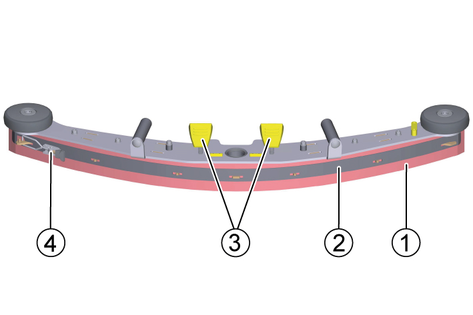
Open the tension lock.
Remove the strap.
Remove the squeegee blade.
Press the turned or new suction lips onto the knobs of the inner part of the suction bar.
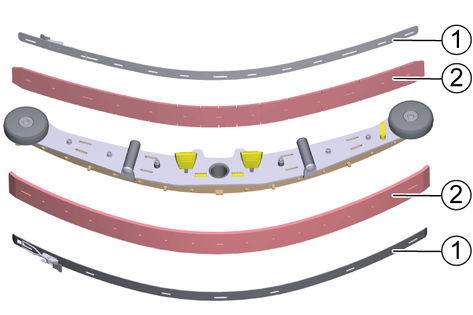
Attach the strap.
Fit the suction bar
Close the eccentric levers (2x).
Pull the tab.
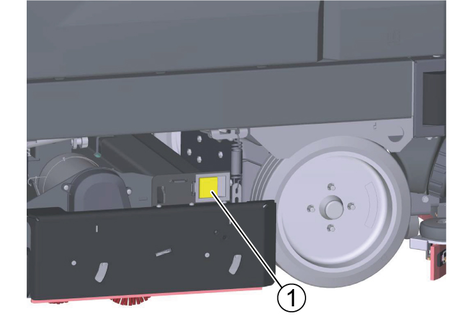
Pivot open the squeegee blade side doors.
Pivot the yellow lever upwards.
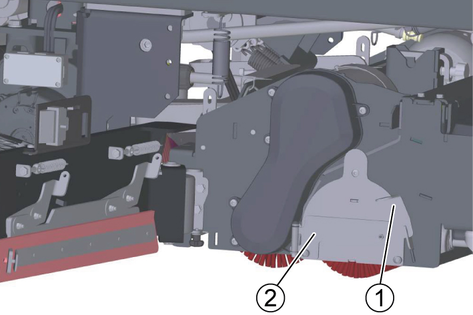
Pivot away the safety flap.
Pull off the brush retaining plate.
Remove the roller brush.
Fit the new roller brush.
When fitting the roller brush, note that it must be placed on the PIN provided in the brush tunnel.

Fit the brush retaining plate again.
Close the safety flap.
Pivot the latch downwards into the hook.
Pivot the squeegee blade side door closed.
Repeat the entire procedure at the other side.
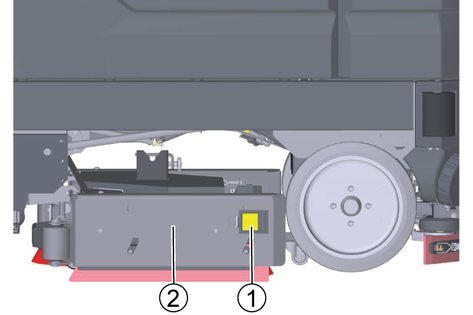
Pull the tab.
Pivot open the squeegee blade side doors.
Unscrew the screws (6x).
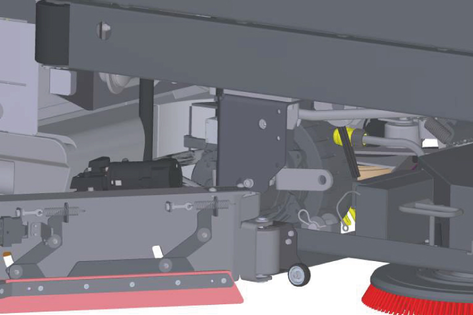
Replace the squeegee blade.
Reinstall the screws (6x).
Close the squeegee blade holder again.
Pull the tab on the side doors.
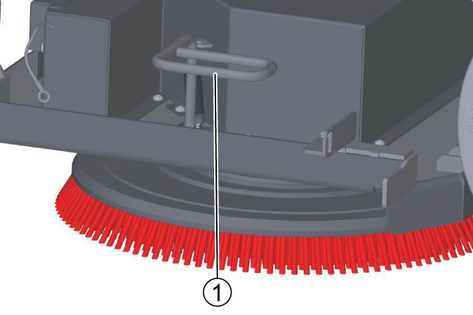
Pivot open the squeegee blade side doors.
Push the bracket downwards.
Pull the disc brush sideways and out from underneath the cleaning head.
Hold the new disc brush under the cleaning head, then press upwards and latch it into position.
Pivot the squeegee blade side doors closed again.
Turn the brush clockwise until the brush holder springs are facing forward.
Pull the brush holder springs apart.
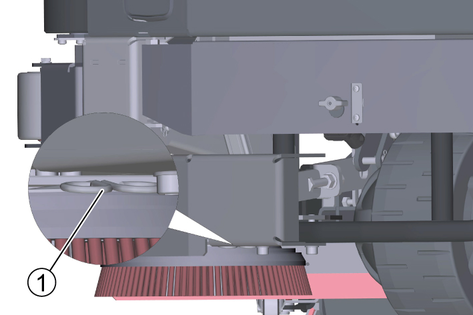
The brush falls out of the holder.
Check the brush for foreign objects (e.g. parcel tape or foil).
Clean the brush under running water.
Pull the brush holder springs apart and fit the brush.
The brush is worn out when the bristle length corresponds to the length of the yellow indicator bristle.
Replace the brush (See Replacing the brush).
Turn the brush clockwise until the brush holder springs are facing forward.
Pull the brush holder springs apart.

The brush falls out of the holder.
Fit the new brush.
Pull the brush holder springs apart and fit the brush.
Unscrew the M6 x 12 screws (6x).
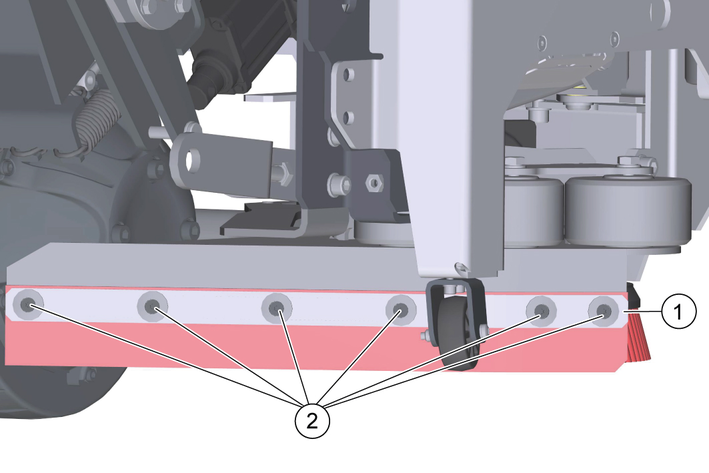
Remove the retaining plate and the squeegee blade.
Fit the new squeegee blade on the retaining plate.
Fasten the retaining plate using the M6 x 12 screws (6x).
Danger of crushing and shearing!
Danger of crushing and shearing due to running belt drives.
It is essential to close and lock the sweeping mechanism hood before you can put the device back into operation after maintenance work.Fold the hood of the pre-sweeping unit forwards.
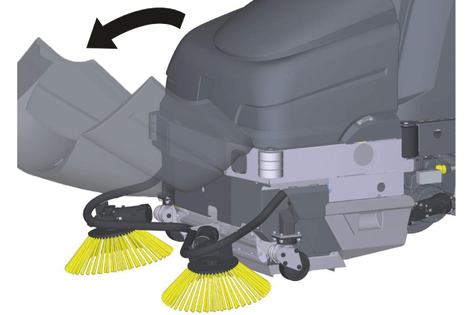
Remove the 4 screws from the protective plate.
Remove the protective plate.
Check the belt of the suction turbine for wear and correct fit.
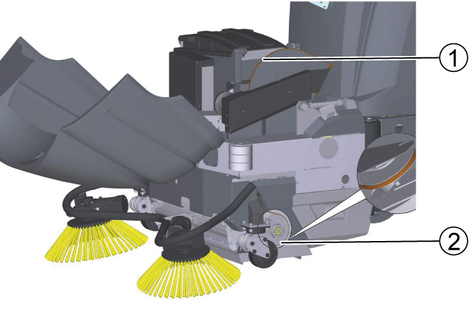
Check the brush roller drive belt for wear and correct seating.
Place the device on a level surface.
Set the program selection switch to "0".
Use a chock to secure the device against rolling away.
Remove the waste containers from both sides.
Front sealing strip
Unscrew the nuts (5x).
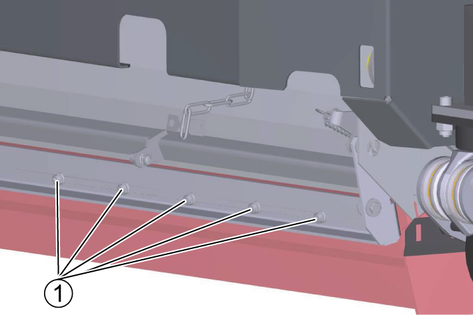
Align the ground clearance of the sealing strip so that it bends to the rear by 35‑40 mm at the ground.
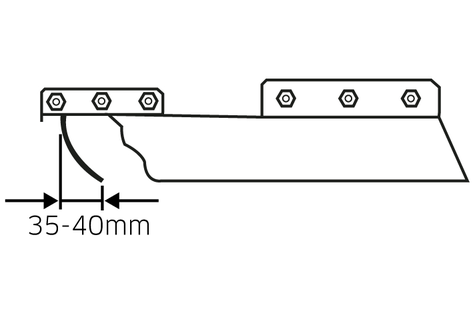
Tighten the nuts (5x).
Rear sealing strip
Adjust the ground clearance of the rear sealing strip so that it bends to the rear by 5‑10 mm at the ground.
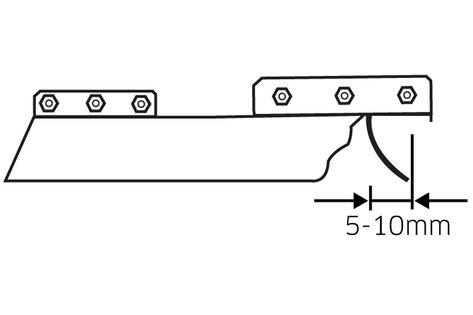
Replace the sealing strip if it is worn.
Remove the roller brush (see chapter Replacing the roller brush).
Unscrew the nuts (7x).

Fit the new sealing strip.
Tighten the nuts (7x).
Side sealing strips
Release the fastening nuts.
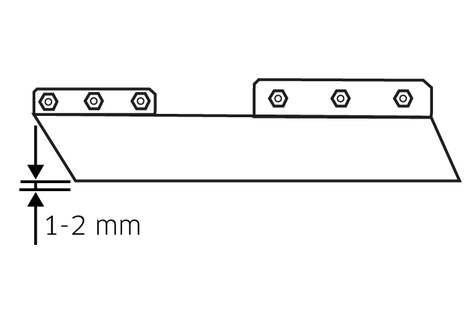
Adjust the ground clearance by inserting an underlay 1‑2 mm thick.
Align the sealing strip.
Tighten the nuts.
Install the roller brush.
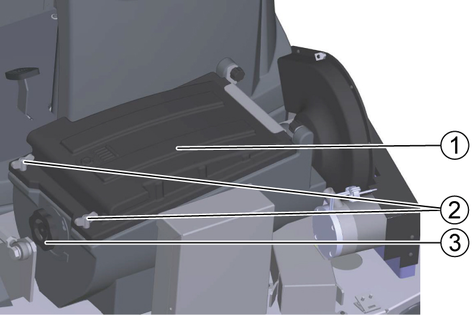
Release the lock of the sweeping mechanism hood by turning it inwards.
Pivot up the sweeping mechanism hood.
Remove the dust filter housing cover.
Remove the screws (2x).
Turn the flange anticlockwise and remove the dust filter bearing.
Remove the dust filter.
Fit the new dust filter so that the holes on the front point to the driver.
Fit the dust filter bearing, turn clockwise and screw tight.
Fit the cover and latch into place.
Close the sweeping mechanism hood.
Secure the hood lock by turning it outwards.
Unscrew the screws (3x).
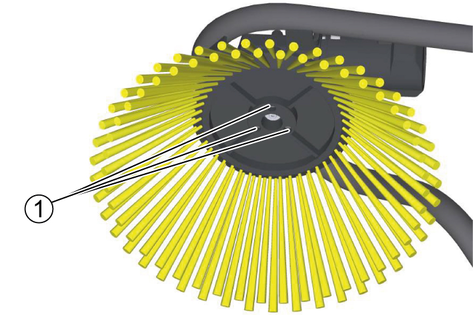
Remove the side brush.
Slide on the new side brush.
Screw in and tighten the 3 screws.
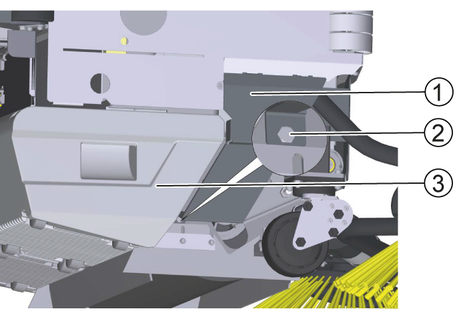
Pull out the waste container.
Unscrew the screw.
Pivot the sheet metal cover upwards and remove it.
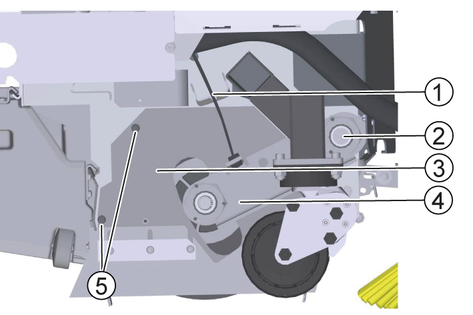
Unhook the Bowden cable.
Unscrew the screw of the swing arm bearing.
Pull off the rocker.
Unscrew both screws of the cover and remove the cover.
Remove the roller brush.
Fit the new roller brush.
Assemble the sweeping mechanism in the reverse order.
Adjust the Bowden cable.
If there is a risk of frost:
Empty the fresh water tank and the waste water tank.
Park the device in a frost-protected room.
Risk of injury if the device is started unintentionally!
Unintentional starting of the device can cause injury to persons working on the device.
Remove the Intelligent Key prior to all work on the device.Before carrying out any work, pull the mains plug of the internal charger out of the socket.Disconnect the battery connector before performing any work.Risk of injury from moving elements!
The suction turbine, side brushes and filter dedusting run on after switching off.
Do not carry out any work on the device until the components have come to a standstill.Drain the waste water.
Drain the remaining fresh water.
If the malfunction cannot be remedied with the following instructions, contact Customer Service.
Only the automotive flat fuses with the following values may be replaced by the operator:
5A– Controller and emergency power supply
20A – Per stroke/accessory module supply
50A – Lift/Clean module 3 (Combo variant)
Damage to the controller!
Improper replacement of the fuses can damage the controller.
Have defective pole fuses replaced only by the Customer Service. If pole fuses are defective, the operating conditions and the entire controller must be checked by the Customer Service.The controller is located below the control panel. To access the fuses, remove the cover on the left side of the footwell.
The fuse assignment can be found on the inside of the cover.
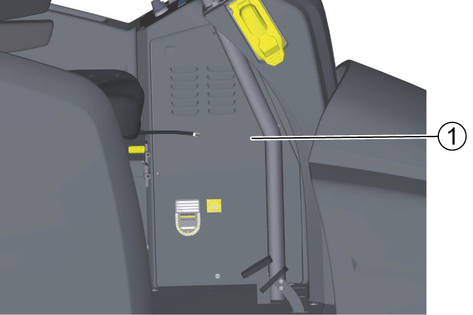
Unscrew the screw (3x).
Remove the bar cover.
Replace the fuse.
Attach the cover.
If faults are shown on the display, proceed as follows:
Fault display as a numerical code
In the event of a fault display with a numerical code, first reset the fault (the device):
Set the program selection switch to "0".
Wait until the display has switched off.
Set the program selection switch to the previous program.
Carry out the appropriate remedial measures in the order given only if the error occurs again. The program selection switch must be in position "0" and the Intelligent Key must have been pulled out.
If the error cannot be rectified, call Customer Service and state the error message.
Fault display as text
Follow the instructions on the display.
Acknowledge the fault by pressing the info button.
Error messages that are not listed in the following table indicate errors that cannot be rectified by the operator. In this case, please call Customer Service.
The device cannot be started
Remedy:
Insert the battery plug.
Only for Li-Ion battery: Press the on/off button on the bottom edge of the separate display.
Set the safety switch to "1".
Insert the Intelligent Key.
Check fuse F1, replace if necessary, (see chapter Replacing fuses).
Check the batteries and charge if necessary.
The water quantity is insufficient
Remedy:
Check the fresh water filling level, if necessary fill the tank completely so that the air is pressed out.
Check the hoses for clogging and clean if necessary.
Remove and clean the fresh water filter.
Open the fresh water ball tap.
The suction performance is too low
Remedy:
Close the lid on the waste water drain hose.
Clean the seals between the waste water tank and the cover, check for leaks and replace if necessary.
Clean the turbine filter.
Clean the suction lips at the suction bar, turn over or replace if necessary.
Check the suction hose for clogging and clean if necessary.
Check the suction hose for leaks and replace if necessary.
Check the adjustment of the suction bar.
The cleaning results are unsatisfactory
Remedy:
Set the appropriate cleaning program for the cleaning task.
Use suitable brushes for the cleaning task.
Use a suitable detergent for the cleaning task.
Reduce the driving speed.
Adjust the contact pressure.
Adjust the squeegee blades.
Check the brushes for wear and replace if necessary.
Check the water output.
The brushes do not rotate
Remedy:
Reduce the contact pressure.
Check if the brushes are blocked by a foreign body and remove the foreign body if necessary.
Remedy:
Check fuse F3, replace if necessary, (see chapter Replacing fuses).
Remedy:
Switch off the device.
Wait one minute.
Switch the device on again.
Remedy:
Check the roller brush and the side brushes for wear, replace if necessary.
If the roller brush does not turn, check the drive belt, clean if necessary.
Check the function of the coarse dirt flap.
Check the sealing strips for wear, adjust or replace if necessary.
Remedy:
Empty the waste container.
Check the drive belts for the sweeping mechanism suction turbine.
Check the sealing sleeve on the suction fan.
Check the dust filter, clean or replace if necessary.
Check the filter box seal.
Check the sealing strip for wear, adjust or replace if necessary.
The cleaning result when sweeping in the edge area is unsatisfactory
Remedy:
Check the height adjustment of the side brushes, adjust if necessary.
Replace the side brushes.
General | |
Travel speed (max.) | 10 km/h |
Transport speed | 10 km/h |
Reverse speed | 6 km/h |
Permissible braking distance on level ground at max. travel speed of 10 km/h | 1,9 m |
Application time depending on brush head, brush contact pressure and roughness of the ground | 5 h |
Theoretical surface coverage | 10000 m2/h |
Theoretical surface coverage with side scrubbing deck | 11200 m2/h |
Theoretical surface coverage with 2 side brushes | 11500 m2/h |
Practical surface coverage with brush head | 7000 m2/h |
Fresh/waste water tank volume | 260 l |
Coarse dirt container capacity | 26 l |
Detergent tank (Dose option) | 10 l |
Detergent dosing range (from - to) | 0-3 % |
Minimum water dosing quantity | 0,9 l/min |
Maximum water dosing quantity | 9 l/min |
Max. surface pressure (incl. driver, water) | 1,33 N/mm2 |
Device performance data | |
Nominal voltage | 36 V |
Battery capacity | 525/630 Ah |
Mean power input | 6500 W |
Driving motor power | 2200 W |
Suction motor power | 2x840 W |
Brush motor power | 2x 1100 W |
Charging time with empty battery (lead acid) | 10 h |
Charging time with empty battery (Li-Ion) | 3 h |
Brush roller drive power | --- W |
Side brushes power (option) | 110 W |
Sweeping mechanism suction turbine power | --- W |
Vacuuming | |
Suction performance, air quantity | 28 x 2 l/s |
Suction performance, vacuum | 14 (140) kPa (mbar) |
Filter area of dust filter | --- m2 |
Vacuum turbine/suction bar | 22/11 (220/110) kPa (mbar) |
Cleaning brushes | |
Brush diameter | 160 mm |
Brush length | 914 mm |
Brush speed | 1250 1/min |
Side scrubbing deck brush speed | 140 1/min |
Side scrubbing deck brush diameter | 300 mm |
Roller brush diameter | --- mm |
Roller brush width | --- mm |
Roller brush speed | --- 1/min |
Side brush diameter | 450 mm |
Dimensions | |
Length | 1925 mm |
Width (without suction bar) | 1040 mm |
Width (with suction bar) | 1140 mm |
Height | 1565 mm |
Height (with overhead guard, flashing beacon) | 2200 mm |
Working width with side scrubbing deck | 1120 mm |
Working width with side brushes | 1150 mm |
Turning radius with smallest equipment(180°) | 2120 mm |
Battery compartment size (LxWxH) | 840 x 625 x 520 mm |
Front wheel, width | 132 mm |
Front wheel, diameter (outside) | 300 mm |
Rear wheel, width | 108 mm |
Rear wheel, diameter (outside) | 375 mm |
Weight | |
Approved total weight | 1840 kg |
Transport weight (with 525/630 Ah battery, 75 kg driver, average Brush head) | 960/1460 kg |
Weight, ready for operation (with 525 / 630 Ah battery and full tank) | 1141/1641 kg |
Brush contact pressure | 150 kg |
Brush contact pressure | 210 g/cm2 |
Load per unit area (with driver and full fresh water tank) | |
Sweeping mechanism wheel surface load | --- N/cm2 |
Load per unit area, front wheel | 207 N/cm2 |
Load per unit area, rear wheel | 60 N/cm2 |
Charger offboard ex works | |
Cable length | 3000 mm |
Voltage | 230 V |
Frequency range | 50/60 Hz |
Dimensions | 420 x 260 x 115 mm |
Weight | 10 kg |
Protection class | IP 21 |
Plug type | Schuko |
Charging current | 65 A |
Charger Li-Ion offboard ex works | |
Cable length | 3000 mm |
Voltage | 380 V |
Frequency range | 50/60 Hz |
Dimensions | 535 x 210 x 360 mm |
Weight | 35 kg |
Protection class | IP 22 |
Plug type | CEE 32 A |
Charging current | 200 A |
Power | 13,3 kW |
Ambient conditions | |
Maximum ambient temperature | 40 °C |
Minimum ambient temperature | 5 °C |
Maximum water temperature | 60 °C |
Incline | |
Maximum gradient (for transport travel) | 15 % |
Maximum gradient (In scrub mode) | 15 % |
Maximum short term gradient (Max. 10 m) | 25 % |
Determined values in acc. with EN 60335-2-72 | |
Total vibration value | ≤ 2,5 m/s2 |
Arm total vibration value | ≤ 2,5 m/s2 |
Hand-arm vibration value, uncertainty K | ≤ 2,5 m/s2 |
Seat surface total vibration value | ≤ 0,5 m/s2 |
Seat vibration value, uncertainty K | ≤ 0,5 m/s2 |
Sound pressure level | 73 dB(A) |
Uncertainty KpA | 3 dB(A) |
Sound power level LWA + uncertainty KWA | 94 dB(A) |
Protection class | IPX3 |
Side scrubbing deck | |
Power | 260 W |
Contact pressure | 9,7 kg |
Contact pressure | 0,00239 N/mm2 |
General | |
Travel speed (max.) | 10 km/h |
Transport speed | 10 km/h |
Reverse speed | 6 km/h |
Permissible braking distance on level ground at max. travel speed of 10 km/h | 1,9 m |
Application time depending on brush head, brush contact pressure and roughness of the ground | 4,5 h |
Theoretical surface coverage | 10000 m2/h |
Theoretical surface coverage with side scrubbing deck | --- m2/h |
Theoretical surface coverage with 2 side brushes | 11500 m2/h |
Practical surface coverage with brush head | 7000 m2/h |
Fresh/waste water tank volume | 260 l |
Coarse dirt container capacity | 26 l |
Detergent tank (Dose option) | 10 l |
Detergent dosing range (from - to) | 0-3 % |
Minimum water dosing quantity | 0,9 l/min |
Maximum water dosing quantity | 9 l/min |
Max. surface pressure (incl. driver, water) | 1,33 N/mm2 |
Device performance data | |
Nominal voltage | 36 V |
Battery capacity | 525/630 Ah |
Mean power input | 7500 W |
Driving motor power | 2200 W |
Suction motor power | 2x840 W |
Brush motor power | 2x 1100 W |
Charging time with empty battery (lead acid) | 10 h |
Charging time with empty battery (Li-Ion) | 3 h |
Brush roller drive power | 600 W |
Side brushes power (option) | 110 W |
Sweeping mechanism suction turbine power | 600 W |
Vacuuming | |
Suction performance, air quantity | 28 x 2 l/s |
Suction performance, vacuum | 14 (140) kPa (mbar) |
Filter area of dust filter | 4 m2 |
Vacuum turbine/suction bar | 22/11 (220/110) kPa (mbar) |
Cleaning brushes | |
Brush diameter | 160 mm |
Brush length | 914 mm |
Brush speed | 1250 1/min |
Side scrubbing deck brush speed | --- 1/min |
Side scrubbing deck brush diameter | --- mm |
Roller brush diameter | 285 mm |
Roller brush width | 710 mm |
Roller brush speed | 610 1/min |
Side brush diameter | 450 mm |
Dimensions | |
Length | 2560 mm |
Width (without suction bar) | 1040 mm |
Width (with suction bar) | 1140 mm |
Height | 1565 mm |
Height (with overhead guard, flashing beacon) | 2200 mm |
Working width with side scrubbing deck | 1120 mm |
Working width with side brushes | 1180 mm |
Turning radius with smallest equipment(180°) | 2950 mm |
Battery compartment size (LxWxH) | 840 x 625 x 520 mm |
Application time depending on brush head, brush contact pressure and roughness of the ground | 4,5 h |
Front wheel, width | 132 mm |
Front wheel, diameter (outside) | 300 mm |
Rear wheel, width | 108 mm |
Rear wheel, diameter (outside) | 375 mm |
Weight | |
Approved total weight | 2020 kg |
Transport weight (with 525/630 Ah battery, 75 kg driver, average Brush head) | 1444/1944 kg |
Weight, ready for operation (with 525 / 630 Ah battery and full tank) | 1345/1845 kg |
Brush contact pressure | 150 kg |
Brush contact pressure | 210 g/cm2 |
Load per unit area (with driver and full fresh water tank) | |
Sweeping mechanism wheel surface load | --- N/cm2 |
Load per unit area, front wheel | 207 N/cm2 |
Load per unit area, rear wheel | 60 N/cm2 |
Charger offboard ex works | |
Cable length | 3000 mm |
Voltage | 230 V |
Frequency range | 50/60 Hz |
Dimensions | 420 x 260 x 115 mm |
Weight | 10 kg |
Protection class | IP 21 |
Plug type | Schuko |
Charging current | 65 A |
Charger Li-Ion offboard ex works | |
Cable length | 3000 mm |
Voltage | 380 V |
Frequency range | 50/60 Hz |
Dimensions | 535 x 210 x 360 mm |
Weight | 35 kg |
Protection class | IP 22 |
Plug type | CEE 32 A |
Charging current | 200 A |
Power | 13,3 kW |
Ambient conditions | |
Maximum ambient temperature | 40 °C |
Minimum ambient temperature | 5 °C |
Maximum water temperature | 60 °C |
Incline | |
Maximum gradient (for transport travel) | 10 % |
Maximum gradient (In scrub mode) | 10 % |
Maximum short term gradient (Max. 10 m) | 25 % |
Determined values in acc. with EN 60335-2-72 | |
Total vibration value | ≤ 2,5 m/s2 |
Arm total vibration value | ≤ 2,5 m/s2 |
Hand-arm vibration value, uncertainty K | ≤ 2,5 m/s2 |
Seat surface total vibration value | ≤ 0,5 m/s2 |
Seat vibration value, uncertainty K | ≤ 0,5 m/s2 |
Sound pressure level | 73 dB(A) |
Uncertainty KpA | 3 dB(A) |
Sound power level LWA + uncertainty KWA | 94 dB(A) |
Protection class | IPX3 |
Side scrubbing deck | |
Power | 260 W |
Contact pressure | 9,7 kg |
Contact pressure | 0,00239 N/mm2 |
General | |
Travel speed (max.) | 10 km/h |
Transport speed | 10 km/h |
Reverse speed | 6 km/h |
Permissible braking distance on level ground at max. travel speed of 10 km/h | 1,9 m |
Application time depending on brush head, brush contact pressure and roughness of the ground | 5 h |
Theoretical surface coverage | 12000 m2/h |
Theoretical surface coverage with side scrubbing deck | --- m2/h |
Theoretical surface coverage with 2 side brushes | 13400 m2/h |
Practical surface coverage with brush head | 8400 m2/h |
Fresh/waste water tank volume | 260 l |
Coarse dirt container capacity | 32 l |
Detergent tank (Dose option) | 10 l |
Detergent dosing range (from - to) | 0-3 % |
Minimum water dosing quantity | 0,9 l/min |
Maximum water dosing quantity | 9 l/min |
Max. surface pressure (incl. driver, water) | 1,33 N/mm2 |
Device performance data | |
Nominal voltage | 36 V |
Battery capacity | 525/630 Ah |
Mean power input | 6500 W |
Driving motor power | 2200 W |
Suction motor power | 2x840 W |
Brush motor power | 2x 1100 W |
Charging time with empty battery (lead acid) | 10 h |
Charging time with empty battery (Li-Ion) | 3 h |
Brush roller drive power | --- W |
Side brushes power (option) | 110 W |
Sweeping mechanism suction turbine power | --- W |
Vacuuming | |
Suction performance, air quantity | 28 x 2 l/s |
Suction performance, vacuum | 14 (140) kPa (mbar) |
Filter area of dust filter | --- m2 |
Vacuum turbine/suction bar | 22/11 (220/110) kPa (mbar) |
Cleaning brushes | |
Brush diameter | 160 mm |
Brush length | 1118 mm |
Brush speed | 1250 1/min |
Side scrubbing deck brush speed | --- 1/min |
Side scrubbing deck brush diameter | --- mm |
Roller brush diameter | --- mm |
Roller brush width | --- mm |
Roller brush speed | --- 1/min |
Side brush diameter | 450 mm |
Dimensions | |
Length | 1925 mm |
Width (without suction bar) | 1040 mm |
Width (with suction bar) | 1340 mm |
Height | 1565 mm |
Height (with overhead guard, flashing beacon) | 2200 mm |
Working width with side scrubbing deck | 1120 mm |
Working width with side brushes | 1340 mm |
Turning radius with smallest equipment(180°) | 2120 mm |
Battery compartment size (LxWxH) | 840 x 625 x 520 mm |
Front wheel, width | 132 mm |
Front wheel, diameter (outside) | 300 mm |
Rear wheel, width | 108 mm |
Rear wheel, diameter (outside) | 375 mm |
Weight | |
Approved total weight | 1840 kg |
Transport weight (with 525/630 Ah battery, 75 kg driver, average Brush head) | 960/1460 kg |
Weight, ready for operation (with 525 / 630 Ah battery and full tank) | 1141/1641 kg |
Brush contact pressure | 150 kg |
Brush contact pressure | 168 g/cm2 |
Load per unit area (with driver and full fresh water tank) | |
Sweeping mechanism wheel surface load | --- N/cm2 |
Load per unit area, front wheel | 207 N/cm2 |
Load per unit area, rear wheel | 60 N/cm2 |
Charger offboard ex works | |
Cable length | 3000 mm |
Voltage | 230 V |
Frequency range | 50/60 Hz |
Dimensions | 420 x 260 x 115 mm |
Weight | 10 kg |
Protection class | IP 21 |
Plug type | Schuko |
Charging current | 65 A |
Charger Li-Ion offboard ex works | |
Cable length | 3000 mm |
Voltage | 380 V |
Frequency range | 50/60 Hz |
Dimensions | 535 x 210 x 360 mm |
Weight | 35 kg |
Protection class | IP 22 |
Plug type | CEE 32 A |
Charging current | 200 A |
Power | 13,3 kW |
Ambient conditions | |
Maximum ambient temperature | 40 °C |
Minimum ambient temperature | 5 °C |
Maximum water temperature | 60 °C |
Incline | |
Maximum gradient (for transport travel) | 15 % |
Maximum gradient (In scrub mode) | 15 % |
Maximum short term gradient (Max. 10 m) | 25 % |
Determined values in acc. with EN 60335-2-72 | |
Total vibration value | ≤ 2,5 m/s2 |
Arm total vibration value | ≤ 2,5 m/s2 |
Hand-arm vibration value, uncertainty K | ≤ 2,5 m/s2 |
Seat surface total vibration value | ≤ 0,5 m/s2 |
Seat vibration value, uncertainty K | ≤ 0,5 m/s2 |
Sound pressure level | 73 dB(A) |
Uncertainty KpA | 3 dB(A) |
Sound power level LWA + uncertainty KWA | 94 dB(A) |
Protection class | IPX3 |
Side scrubbing deck | |
Power | 260 W |
Contact pressure | 9,7 kg |
Contact pressure | 0,00239 N/mm2 |
General | |
Travel speed (max.) | 10 km/h |
Transport speed | 10 km/h |
Reverse speed | 6 km/h |
Permissible braking distance on level ground at max. travel speed of 10 km/h | 1,9 m |
Application time depending on brush head, brush contact pressure and roughness of the ground | 4,5 h |
Theoretical surface coverage | 12000 m2/h |
Theoretical surface coverage with side scrubbing deck | --- m2/h |
Theoretical surface coverage with 2 side brushes | 13400 m2/h |
Practical surface coverage with brush head | 8400 m2/h |
Fresh/waste water tank volume | 260 l |
Coarse dirt container capacity | 32 l |
Detergent tank (Dose option) | 10 l |
Detergent dosing range (from - to) | 0-3 % |
Minimum water dosing quantity | 0,9 l/min |
Maximum water dosing quantity | 9 l/min |
Max. surface pressure (incl. driver, water) | 1,33 N/mm2 |
Device performance data | |
Nominal voltage | 36 V |
Battery capacity | 525/630 Ah |
Mean power input | 7500 W |
Driving motor power | 2200 W |
Suction motor power | 2x840 W |
Brush motor power | 2x 1100 W |
Charging time with empty battery (lead acid) | 10 h |
Charging time with empty battery (Li-Ion) | 3 h |
Brush roller drive power | 600 W |
Side brushes power (option) | 110 W |
Sweeping mechanism suction turbine power | 600 W |
Vacuuming | |
Suction performance, air quantity | 28 x 2 l/s |
Suction performance, vacuum | 14 (140) kPa (mbar) |
Filter area of dust filter | 4 m2 |
Vacuum turbine/suction bar | 22/11 (220/110) kPa (mbar) |
Cleaning brushes | |
Brush diameter | 160 mm |
Brush length | 1118 mm |
Brush speed | 1250 1/min |
Side scrubbing deck brush speed | --- 1/min |
Side scrubbing deck brush diameter | --- mm |
Roller brush diameter | 285 mm |
Roller brush width | 710 mm |
Roller brush speed | 610 1/min |
Side brush diameter | 450 mm |
Dimensions | |
Length | 2560 mm |
Width (without suction bar) | 1040 mm |
Width (with suction bar) | 1340 mm |
Height | 1565 mm |
Height (with overhead guard, flashing beacon) | 2200 mm |
Working width with side scrubbing deck | 1120 mm |
Working width with side brushes | 1340 mm |
Turning radius with smallest equipment(180°) | 2950 mm |
Battery compartment size (LxWxH) | 840 x 625 x 520 mm |
Front wheel, width | 132 mm |
Front wheel, diameter (outside) | 300 mm |
Rear wheel, width | 108 mm |
Rear wheel, diameter (outside) | 375 mm |
Weight | |
Approved total weight | 2020 kg |
Transport weight (with 525/630 Ah battery, 75 kg driver, average Brush head) | 1444/1944 kg |
Weight, ready for operation (with 525 / 630 Ah battery and full tank) | 1345/1845 kg |
Brush contact pressure | 150 kg |
Brush contact pressure | 168 g/cm2 |
Load per unit area (with driver and full fresh water tank) | |
Sweeping mechanism wheel surface load | --- N/cm2 |
Load per unit area, front wheel | 207 N/cm2 |
Load per unit area, rear wheel | 60 N/cm2 |
Charger offboard ex works | |
Cable length | 3000 mm |
Voltage | 230 V |
Frequency range | 50/60 Hz |
Dimensions | 420 x 260 x 115 mm |
Weight | 10 kg |
Protection class | IP 21 |
Plug type | Schuko |
Charging current | 65 A |
Charger Li-Ion offboard ex works | |
Cable length | 3000 mm |
Voltage | 380 V |
Frequency range | 50/60 Hz |
Dimensions | 535 x 210 x 360 mm |
Weight | 35 kg |
Protection class | IP 22 |
Plug type | CEE 32 A |
Charging current | 200 A |
Power | 13,3 kW |
Ambient conditions | |
Maximum ambient temperature | 40 °C |
Minimum ambient temperature | 5 °C |
Maximum water temperature | 60 °C |
Incline | |
Maximum gradient (for transport travel) | 10 % |
Maximum gradient (In scrub mode) | 10 % |
Maximum short term gradient (Max. 10 m) | 25 % |
Determined values in acc. with EN 60335-2-72 | |
Total vibration value | ≤ 2,5 m/s2 |
Arm total vibration value | ≤ 2,5 m/s2 |
Hand-arm vibration value, uncertainty K | ≤ 2,5 m/s2 |
Seat surface total vibration value | ≤ 0,5 m/s2 |
Seat vibration value, uncertainty K | ≤ 0,5 m/s2 |
Sound pressure level | 73 dB(A) |
Uncertainty KpA | 3 dB(A) |
Sound power level LWA + uncertainty KWA | 94 dB(A) |
Protection class | IPX3 |
Side scrubbing deck | |
Power | 260 W |
Contact pressure | 9,7 kg |
Contact pressure | 0,00239 N/mm2 |
General | |
Travel speed (max.) | 10 km/h |
Transport speed | 10 km/h |
Reverse speed | 6 km/h |
Permissible braking distance on level ground at max. travel speed of 10 km/h | 1,9 m |
Application time depending on brush head, brush contact pressure and roughness of the ground | 5 h |
Theoretical surface coverage | 10000 m2/h |
Theoretical surface coverage with side scrubbing deck | 11200 m2/h |
Theoretical surface coverage with 2 side brushes | 11500 m2/h |
Practical surface coverage with brush head | 7000 m2/h |
Fresh/waste water tank volume | 260 l |
Coarse dirt container capacity | --- l |
Detergent tank (Dose option) | 10 l |
Detergent dosing range (from - to) | 0-3 % |
Minimum water dosing quantity | 0,9 l/min |
Maximum water dosing quantity | 9 l/min |
Max. surface pressure (incl. driver, water) | 1,33 N/mm2 |
Device performance data | |
Nominal voltage | 36 V |
Battery capacity | c Ah |
Mean power input | 6500 W |
Driving motor power | 2200 W |
Suction motor power | 2x840 W |
Brush motor power | 2x 1100 W |
Charging time with empty battery (lead acid) | 10 h |
Charging time with empty battery (Li-Ion) | 3 h |
Brush roller drive power | --- W |
Side brushes power (option) | 110 W |
Sweeping mechanism suction turbine power | --- W |
Vacuuming | |
Suction performance, air quantity | 28 x 2 l/s |
Suction performance, vacuum | 14 (140) kPa (mbar) |
Filter area of dust filter | --- m2 |
Vacuum turbine/suction bar | 22/11 (220/110) kPa (mbar) |
Cleaning brushes | |
Brush diameter | 510 mm |
Brush length | --- mm |
Brush speed | 140 1/min |
Side scrubbing deck brush speed | 140 1/min |
Side scrubbing deck brush diameter | 300 mm |
Roller brush diameter | --- mm |
Roller brush width | --- mm |
Roller brush speed | --- 1/min |
Side brush diameter | 450 mm |
Dimensions | |
Length | 1925 mm |
Width (without suction bar) | 1040 mm |
Width (with suction bar) | 1140 mm |
Height | 1565 mm |
Height (with overhead guard, flashing beacon) | 2200 mm |
Working width with side scrubbing deck | 1120 mm |
Working width with side brushes | 1150 mm |
Turning radius with smallest equipment(180°) | 2120 mm |
Battery compartment size (LxWxH) | 840 x 625 x 520 mm |
Front wheel, width | 132 mm |
Front wheel, diameter (outside) | 300 mm |
Rear wheel, width | 108 mm |
Rear wheel, diameter (outside) | 375 mm |
Weight | |
Approved total weight | 1840 kg |
Transport weight (with 525/630 Ah battery, 75 kg driver, average Brush head) | 960/1460 kg |
Weight, ready for operation (with 525 / 630 Ah battery and full tank) | 1141/1641 kg |
Brush contact pressure | 130 kg |
Brush contact pressure | 42 g/cm2 |
Load per unit area (with driver and full fresh water tank) | |
Sweeping mechanism wheel surface load | --- N/cm2 |
Load per unit area, front wheel | 207 N/cm2 |
Load per unit area, rear wheel | 60 N/cm2 |
Charger offboard ex works | |
Cable length | 3000 mm |
Voltage | 230 V |
Frequency range | 50/60 Hz |
Dimensions | 420 x 260 x 115 mm |
Weight | 10 kg |
Protection class | IP 21 |
Plug type | Schuko |
Charging current | 65 A |
Charger Li-Ion offboard ex works | |
Cable length | 3000 mm |
Voltage | 380 V |
Frequency range | 50/60 Hz |
Dimensions | 535 x 210 x 360 mm |
Weight | 35 kg |
Protection class | IP 22 |
Plug type | CEE 32 A |
Charging current | 200 A |
Power | 13,3 kW |
Ambient conditions | |
Maximum ambient temperature | 40 °C |
Minimum ambient temperature | 5 °C |
Maximum water temperature | 60 °C |
Incline | |
Maximum gradient (for transport travel) | 15 % |
Maximum gradient (In scrub mode) | 15 % |
Maximum short term gradient (Max. 10 m) | 25 % |
Determined values in acc. with EN 60335-2-72 | |
Total vibration value | ≤ 2,5 m/s2 |
Arm total vibration value | ≤ 2,5 m/s2 |
Hand-arm vibration value, uncertainty K | ≤ 2,5 m/s2 |
Seat surface total vibration value | ≤ 0,5 m/s2 |
Seat vibration value, uncertainty K | ≤ 0,5 m/s2 |
Sound pressure level | 73 dB(A) |
Uncertainty KpA | 3 dB(A) |
Sound power level LWA + uncertainty KWA | 94 dB(A) |
Protection class | IPX3 |
Side scrubbing deck | |
Power | 260 W |
Contact pressure | 9,7 kg |
Contact pressure | 0,00239 N/mm2 |
General | |
Travel speed (max.) | 10 km/h |
Transport speed | 10 km/h |
Reverse speed | 6 km/h |
Permissible braking distance on level ground at max. travel speed of 10 km/h | 1,9 m |
Application time depending on brush head, brush contact pressure and roughness of the ground | 4,5 h |
Theoretical surface coverage | 10000 m2/h |
Theoretical surface coverage with side scrubbing deck | --- m2/h |
Theoretical surface coverage with 2 side brushes | 11500 m2/h |
Practical surface coverage with brush head | 7000 m2/h |
Fresh/waste water tank volume | 260 l |
Coarse dirt container capacity | --- l |
Detergent tank (Dose option) | 10 l |
Detergent dosing range (from - to) | 0-3 % |
Minimum water dosing quantity | 0,9 l/min |
Maximum water dosing quantity | 9 l/min |
Max. surface pressure (incl. driver, water) | 1,33 N/mm2 |
Device performance data | |
Nominal voltage | 36 V |
Battery capacity | 630 Ah |
Mean power input | 8900 W |
Driving motor power | 2200 W |
Suction motor power | 2x840 W |
Brush motor power | 2x 1100 W |
Charging time with empty battery (lead acid) | 10 h |
Charging time with empty battery (Li-Ion) | 3 h |
Brush roller drive power | 600 W |
Side brushes power (option) | 110 W |
Sweeping mechanism suction turbine power | 600 W |
Vacuuming | |
Suction performance, air quantity | 28 x 2 l/s |
Suction performance, vacuum | 14 (140) kPa (mbar) |
Filter area of dust filter | 4 m2 |
Vacuum turbine/suction bar | 22/11 (220/110) kPa (mbar) |
Cleaning brushes | |
Brush diameter | 510 mm |
Brush length | --- mm |
Brush speed | 140 1/min |
Side scrubbing deck brush speed | --- 1/min |
Side scrubbing deck brush diameter | --- mm |
Roller brush diameter | 285 mm |
Roller brush width | 710 mm |
Roller brush speed | 610 1/min |
Side brush diameter | 450 mm |
Dimensions | |
Length | 2560 mm |
Width (without suction bar) | 1040 mm |
Width (with suction bar) | 1140 mm |
Height | 1565 mm |
Height (with overhead guard, flashing beacon) | 2200 mm |
Working width with side scrubbing deck | 1120 mm |
Working width with side brushes | 1180 mm |
Turning radius with smallest equipment(180°) | 2950 mm |
Battery compartment size (LxWxH) | 840 x 625 x 520 mm |
Front wheel, width | 132 mm |
Front wheel, diameter (outside) | 300 mm |
Rear wheel, width | 108 mm |
Rear wheel, diameter (outside) | 375 mm |
Weight | |
Approved total weight | 2020 kg |
Transport weight (with 525/630 Ah battery, 75 kg driver, average Brush head) | 1444/1944 kg |
Weight, ready for operation (with 525 / 630 Ah battery and full tank) | 1345/1845 kg |
Brush contact pressure | 130 kg |
Brush contact pressure | 42 g/cm2 |
Load per unit area (with driver and full fresh water tank) | |
Sweeping mechanism wheel surface load | --- N/cm2 |
Load per unit area, front wheel | 207 N/cm2 |
Load per unit area, rear wheel | 60 N/cm2 |
Charger offboard ex works | |
Cable length | 3000 mm |
Voltage | 230 V |
Frequency range | 50/60 Hz |
Dimensions | 420 x 260 x 115 mm |
Weight | 10 kg |
Protection class | IP 21 |
Plug type | Schuko |
Charging current | 65 A |
Charger Li-Ion offboard ex works | |
Cable length | 3000 mm |
Voltage | 380 V |
Frequency range | 50/60 Hz |
Dimensions | 535 x 210 x 360 mm |
Weight | 35 kg |
Protection class | IP 22 |
Plug type | CEE 32 A |
Charging current | 200 A |
Power | 13,3 kW |
Ambient conditions | |
Maximum ambient temperature | 40 °C |
Minimum ambient temperature | 5 °C |
Maximum water temperature | 60 °C |
Incline | |
Maximum gradient (for transport travel) | 10 % |
Maximum gradient (In scrub mode) | 10 % |
Maximum short term gradient (Max. 10 m) | 25 % |
Determined values in acc. with EN 60335-2-72 | |
Total vibration value | ≤ 2,5 m/s2 |
Arm total vibration value | ≤ 2,5 m/s2 |
Hand-arm vibration value, uncertainty K | ≤ 2,5 m/s2 |
Seat surface total vibration value | ≤ 0,5 m/s2 |
Seat vibration value, uncertainty K | ≤ 0,5 m/s2 |
Sound pressure level | 73 dB(A) |
Uncertainty KpA | 3 dB(A) |
Sound power level LWA + uncertainty KWA | 94 dB(A) |
Protection class | IPX3 |
Side scrubbing deck | |
Power | 260 W |
Contact pressure | 9,7 kg |
Contact pressure | 0,00239 N/mm2 |
We hereby declare that the machine described below complies with the relevant basic safety and health requirements in the EU Directives, both in its basic design and construction as well as in the version placed in circulation by us. This declaration is invalidated by any changes made to the machine that are not approved by us.
Product: Floor cleaning ride-on machine
Type: 1.480-xxx / 2.480-xxx
Currently applicable EU Directives2006/42/EC (+2009/127/EC)
2014/30/EU
2014/53/EU (TCU)
Harmonised standards usedEN 60335-1
EN 60335-2-72
EN 62233: 2008
EN 55012: 2007 + A1: 2009
EN 61000-6-2: 2005
TCUEN 300 328 V2.2.2
EN 300 330 V2.1.1
EN 300 440 V2.1.1
EN 301 511 V12.5.1
National standards used-
The signatories act on behalf of and with the authority of the company management.

Documentation supervisor:
S. Reiser
Alfred Kärcher SE & Co. KG
Alfred-Kärcher-Str. 28 - 40
71364 Winnenden (Germany)
Ph.: +49 7195 14-0
Fax: +49 7195 14-2212
Winnenden, 2021/03/01
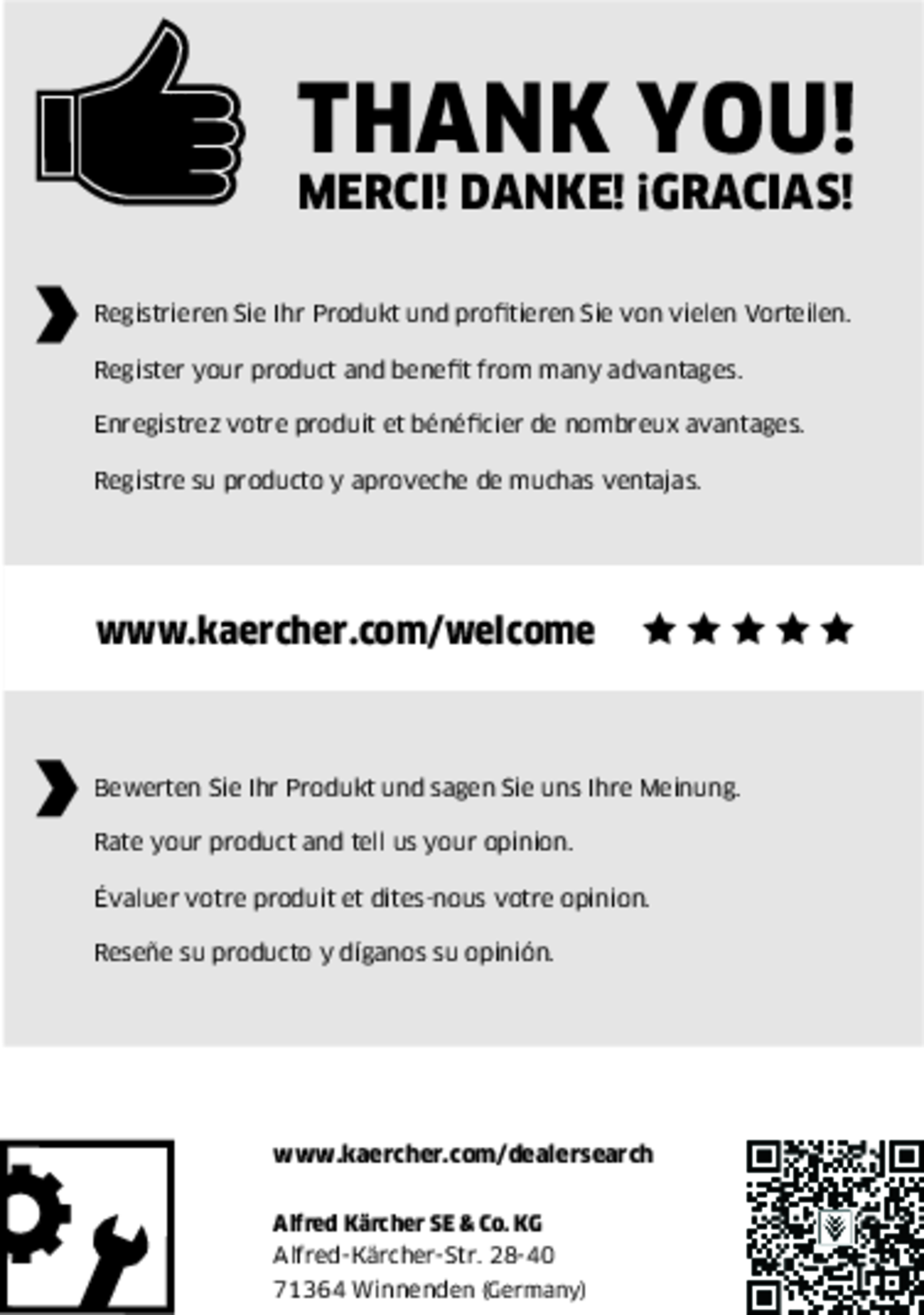
2-2-SC-A4-GS-aw19869